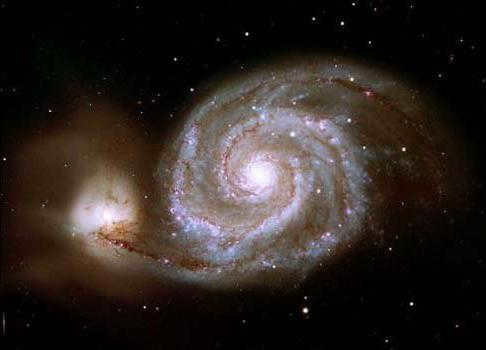In this initial lesson, we will explore the methods for locating neighboring constellations such as the Little Dipper (which includes the renowned Polaris), the Dragon, and Cassiopeia.
What is the reason behind the name “Big Dipper”?
Which individual did Zeus transform into the Big Dipper constellation?
Zeus and Arcadus were elevated to the heavens and metamorphosed into the constellation Volopassus. Volopas is forever fated to honor his mother, the Big Dipper.
What is the reason behind the Big Dipper having a tail?
The Greeks had their own interpretation for the presence of a tail in the bear: Zeus, in his effort to position the Bear in the celestial sphere, gripped her by the tail, swung her, and launched her into the sky. As a result of this powerful throw, the bear’s tail elongated and curved – this is the formation we currently observe as the Big Dipper constellation.
What is the method to locate the Big Dipper constellation in the night sky?
Take a close observation of the Big Dipper. Towards its right, there are two additional stars that are nearly aligned with the stars Dubhe and Merak. These stars are known as 23 and ipsilon (υ) of the Big Dipper. At an even greater distance, you will find the star omicron (ο) of the Big Dipper.
What are the stars in close proximity to the constellation Ursa Major?
The constellation Ursa Major, commonly known as the Big Dipper, is comprised of seven stars that have been labeled with Greek letters: α (alpha), β (beta), γ (gamma), δ (delta), ε (epsilon), ζ (zeta), and η (eta). Adjacent to the star ζ in the Big Dipper, which is also known as Mitzar, there is a faint star called Alcor. Alcor is only visible to those with keen eyesight.
What is a different name for the Big Dipper?
Why does the Big Dipper remain in a constant position?
The reason for the Big Dipper’s consistent location is due to the combination of Earth’s axial rotation and its orbit around the Sun. … The Earth’s position remains the same in relation to the stars, indicating directions 1 and 2.
What is the origin of the names of the constellations?
How did the Big Dipper come to be in the celestial sphere?
In order to rescue the beautiful woman, Zeus sent her to the heavens alongside his son, resulting in the creation of two constellations of varying sizes. According to an ancient Greek myth, Zeus transformed the nymph Callisto into the Big Dipper to protect her from Hera’s wrath. … Zeus transformed them into animals that now appear as the Big Dipper and Little Dipper in the sky.
Where is Polaris visible?
Polaris is constantly positioned above the northern point of the horizon in the Northern Hemisphere, making it an excellent reference point for navigating terrain.
Which star in the Big Dipper forms a binary system?
What is the star located in the tail of the Little Dipper?
What is the reason behind Polaris always remaining fixed in position?
Polaris holds a unique position as it is the closest star visible to the naked eye to the north pole of the Earth, at a distance of approximately 1°. Due to this proximity, it remains in the same position constantly, irrespective of the time of day or year.
Where can you find the small bear?
Discovering the whereabouts of the Little Bear
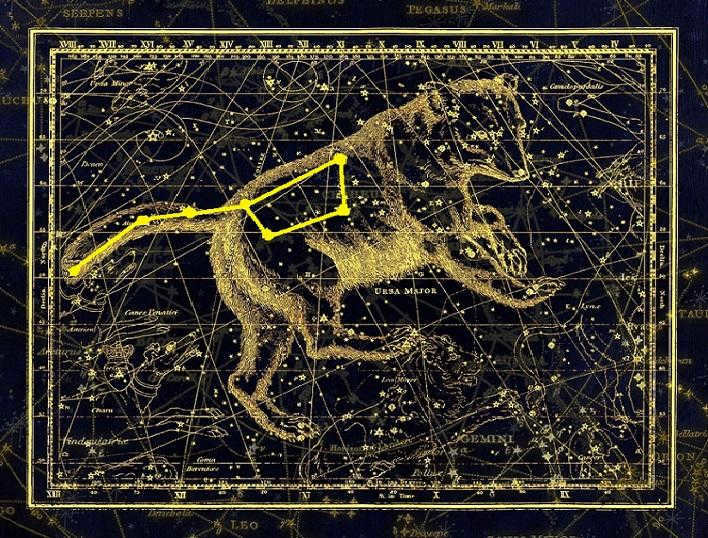
Scientific name
As discussed in the previous post, there are two types of names for star clusters and regions of space: scientific names and folk names. In Russian, The Big Dipper is a scientific name. It is a direct translation from Latin. Ursa Major (and Little Bear is a translation of the Latin Ursa Minor). Latin, being the universal language of science, serves as the foundation for international scientific astronomical names.
However, it is possible that this translation is not from the Latin cosmonym, but from the French (La Grande Ourse) or German (der Groẞe Bär). The latter options are also accurate translations of the Latin name.
In the Latin language, the name Ursa Major has its roots in the ancient Greek term Άρκτος (Arktos) meaning ‘Bear, Bear’ or Μεγάλη Άρκτος (Megale Arktos) meaning ‘Big Dipper’. The ancient Greeks had a fascinating myth about the origin of this well-known constellation in the Northern Hemisphere. According to the myth, the supreme god Zeus was enamored with a nymph, known as Callisto (or in another version, the daughter of the king of Arcadia). Zeus’ wife, the goddess Hera, was furious and transformed the unfortunate nymph into a bear. To protect Callisto from harm, Zeus cast his beloved into the heavens, where she was transformed into a constellation.
Despite the fact that the Greeks created a poetic legend about Callisto the Bear, it is probable that the name of the constellation predates this narrative. It can be traced back to ancient civilizations that were primarily involved in cattle herding and hunting. These could have been tribes that spoke the Proto-Indo-European language. There is also a theory that the Greeks adopted the term from the East (a region from which they obtained much astronomical knowledge), specifically from the Phoenicians or Assyrians.
Folk names
The Big Dipper is known by various names in different languages. Some of the common names for this constellation are Bear, Moose, Wagon, and Sickle.
Of particular interest are the Russian variations. To discover the historical names of the Big Dipper in Russia, one must consult ancient written records and Russian dialects.
There is a wealth of information on the names of the Big Dipper in the materials of govorovory. M. E. Ruth, a researcher of Russian astronomy and cosmonymy, has identified over fifty distinct names for this constellation in various dialects.
The most common Russian folk name for the Big Dipper is the Elk (occasionally in the North – Losikha or Big Elk; sometimes Moose Head, Moose Horns, Moose Stars.). This term is used in dialects across Russia, except for the south and southwest. In Siberia, there was also an alternate name. Sokhatiy. In the northern part of the European region, the names Deer, Olenyok.
Due to its resemblance to other curved household objects, the term spread in the south and partially in Siberia. Koromyslo; in the North – Sickle; in the Don dialect – Yarmo and Chipega. The latter, apparently, comes from the dialect word chapiga ‘wooden plow frame’, ‘tool for cleaning the plow’.
In numerous colloquial expressions, the Big Dipper is referred to as the Kovsh, Big Kovsh, Kovshik. In the Sverdlovsk region, a name with similar imagery was discovered, known as Povaryonka, or ‘Povaryoshka’, while in the North it is called Spoon, Leika, and Popyryka (in the northern dialect, leika means ‘birch bark ladle’ and popyryka means ‘wooden ladle’).
There are also specific names in dialects such as Medveditsa, Medvedka. It is challenging to determine their age, as it is possible that they originated under the influence of scientific names.
Less common are the names created based on the images of other animals, including Bunny, Wolf, Serpent, and Duck.
Also known as The Seven Stars, the Seven Weeks, the Seven Sevens, and Seven, the Big Dipper is referred to by different names based on the number of stars it contains. There is even an unusual variant called Seven Horse Robbers, which traces back to a Turkic cosonym meaning 'seven horse thieves' in its literal translation.
When discussing folk cosonyms, it is important to note that they have become part of history and are rarely used in everyday speech. Many dialect speakers are unaware or have limited knowledge of the traditional names of constellations, often assigning them to the wrong celestial objects. It is possible that, due to such errors, the Big Dipper has been mistakenly referred to as Stozharas, Volosozharas (which are actually proper names for the Pleiades constellation), among others.
The Great Bear is a star pattern located in the northern part of the celestial sphere. The Great Bear ranks as the third largest constellation in terms of its size (following Hydra and Virgo).
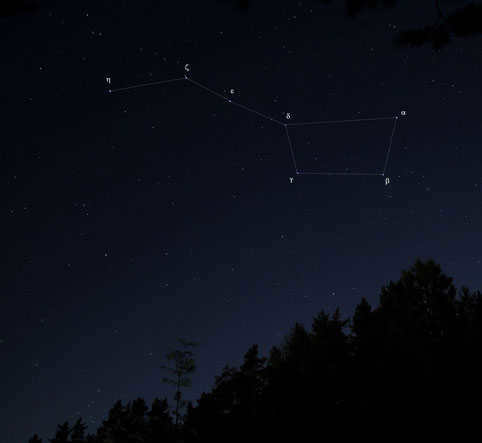

Legend
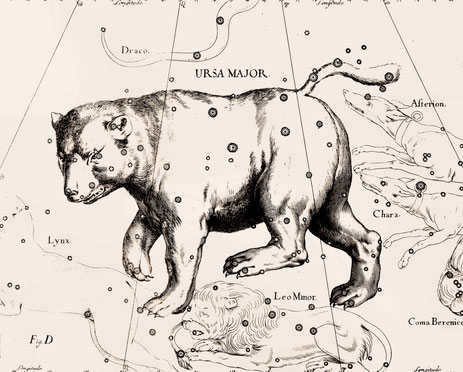
According to Greek mythology, the Big Dipper got its name because Zeus transformed a nymph named Callisto into the constellation to protect her from Hera’s wrath. Another legend, recounted by Philemon of Syracuse, tells the story of two Cretan nymphs who were turned into bears by Zeus as infants to hide them from Cronus. Later, Zeus transported them to the sky as the Big and Little Dippers.
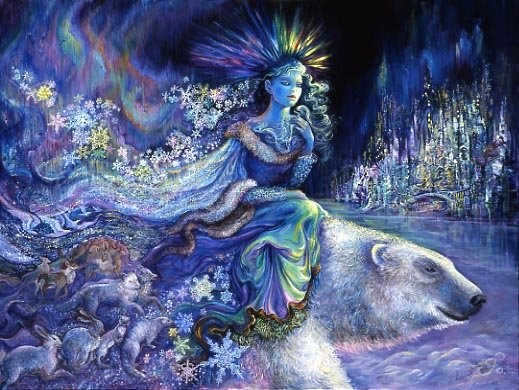
Stars and celestial bodies
The well-known constellation’s seven prominent stars create the renowned Big Dipper; this pattern has been recognized since ancient times by various civilizations with various designations: The Dipper, Plough, Moose, Cart, Seven Wise Men, and so on.
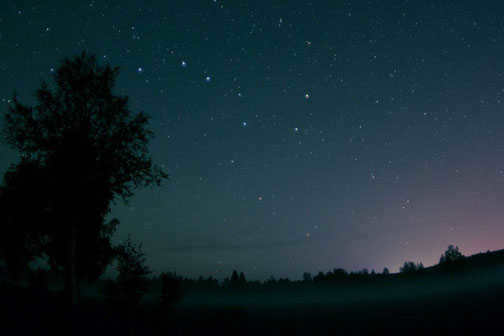
By utilizing the two outermost stars of this constellation, namely α and β, one can easily locate Polaris. The stars Merak and Dubhe, which make up the wall of the Bucket, are commonly referred to as Pointers, due to the fact that the straight line connecting them points directly to Polaris, located in the Little Bear constellation.
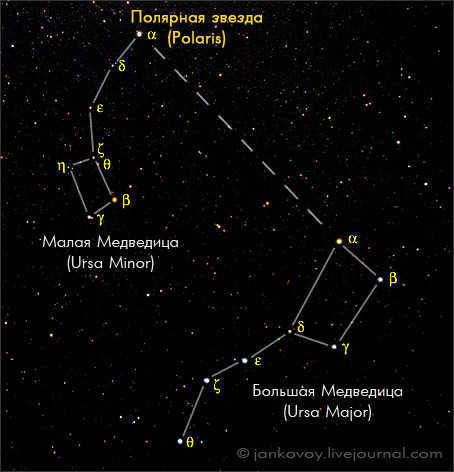
The Ladle consists of six stars that have a brightness of 2nd magnitude, with only Megrets being the exception, as it has a brightness of 3rd magnitude.
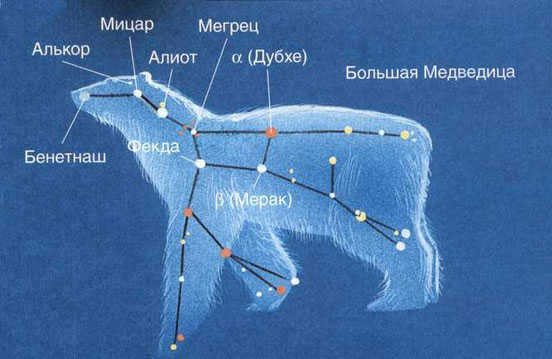
It is interesting to note that, with the exception of the outermost α and η stars, the 5 inner stars of the Big Dipper actually belong to a single moving cluster in space. This cluster moves quite rapidly across the sky, with Dubhe and Benetnash moving in the opposite direction. As a result, the shape of the Big Dipper changes significantly over a period of approximately 100,000 years.
The Big Dipper is also a part of a larger group of galaxies, with the spiral galaxy M81 and the spindle galaxy M82 at its core. These two galaxies are separated by an angle of only 38' and are likely the closest group of galaxies to us, at a distance of approximately 7 million light-years. Additionally, the pyral galaxy M101 is observed from a unique angle, appearing flat on its face.
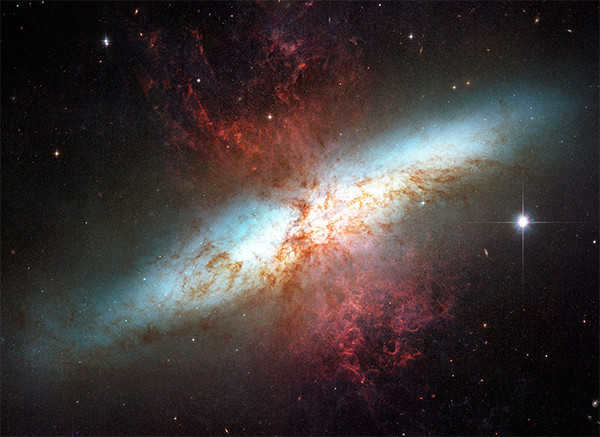

However, the Owl (M97), which lacks distinctive features, is hundreds of times closer to us – it is located within our own Galaxy.
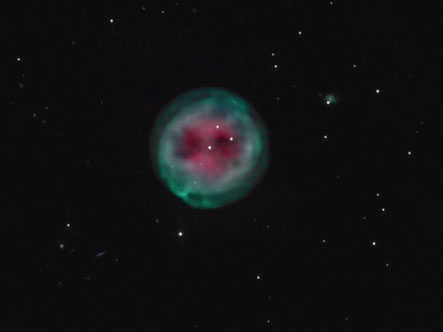
Observing
The optimal visibility conditions occur during March and April. It can be seen all year round across Russia, except during the autumn months in southern Russia when the Big Dipper is low on the horizon.
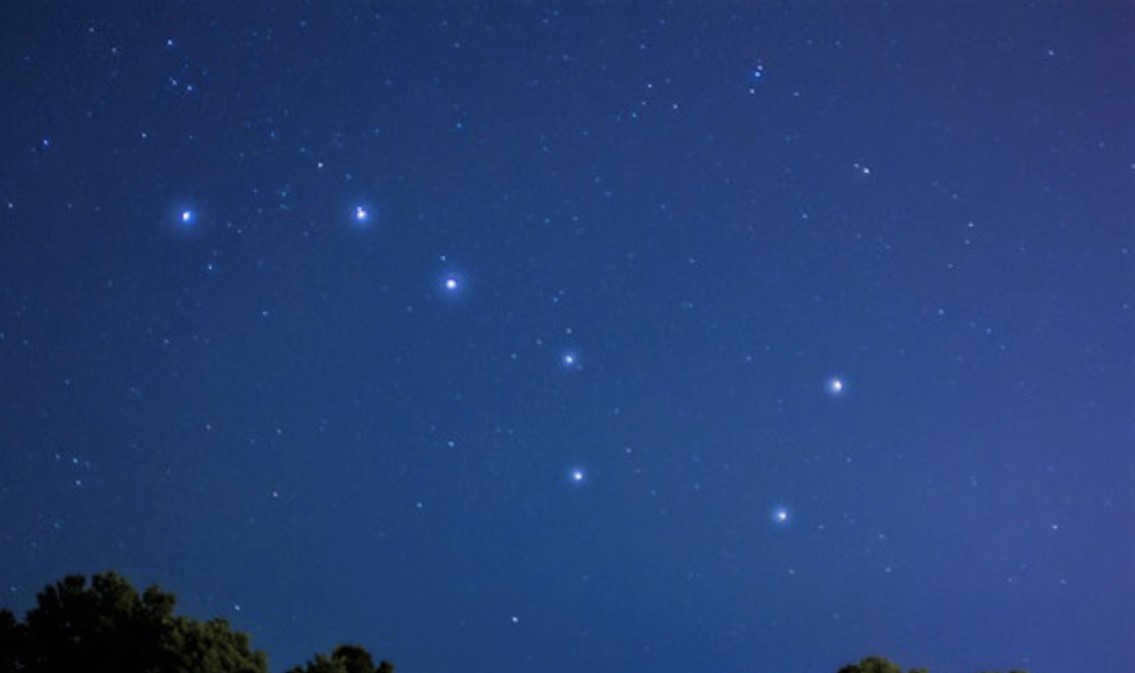
The Big Dipper is a highly popular constellation that can easily be spotted in the night sky without the need for a telescope. Its bright stars have made it a well-known reference point for travelers since ancient times, and scientists have extensively studied this cluster. Astronomers regularly observe the Big Dipper, which leads to exciting discoveries and a deepening understanding of the universe’s structure.
The appearance, description, and characteristics of the Big Dipper
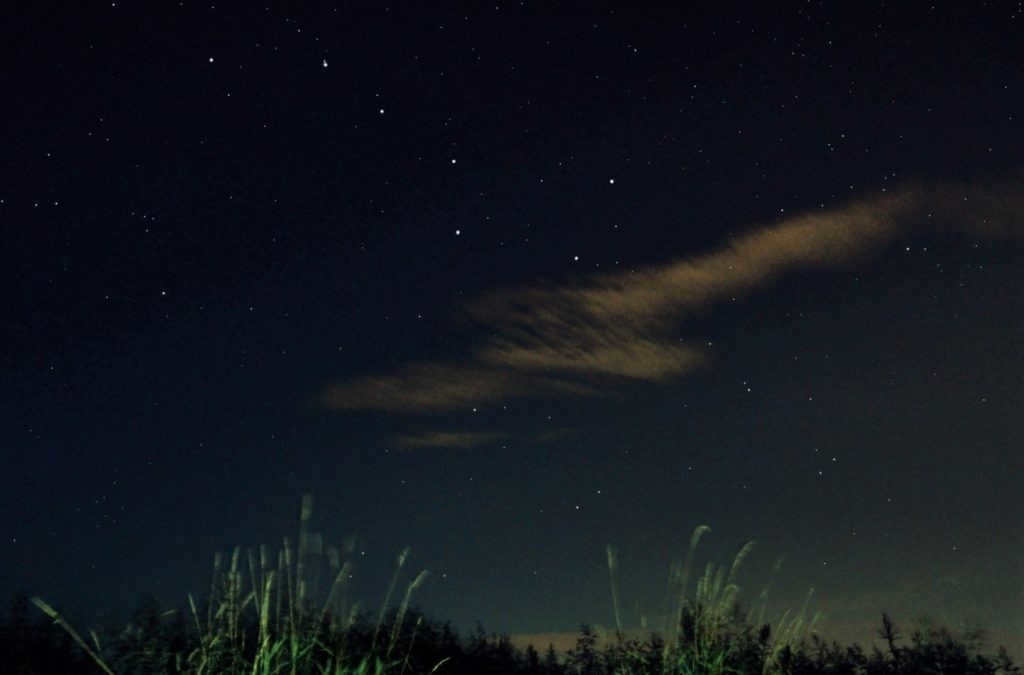
A stunning photograph capturing the Big Dipper against the backdrop of a starry night sky.
Ursa Major, more commonly known as the Big Dipper, is one of the largest constellations in existence. Covering over 3% of the entire celestial sphere, it spans an impressive 1279.66 square degrees. Orbiting around Polaris, the North Star, the Big Dipper is visible above the horizon all year round, making it a prominent feature in the night sky.
Comprised of seven bright stars, the constellation forms the shape of a large ladle or dipper, with a distinctive curved handle. In Latin, Ursa Major translates to “Great Bear” and is often abbreviated as UMa.
Given its considerable size, it’s no surprise that the Big Dipper shares its borders with several other constellations. These neighboring clusters include Draco, Camelopardalis, Coma Berenices, Canes Venatici, and Leo Minor.
Did you know that in the fall, there was a belief among Native Americans that the Big Dipper’s descent to the horizon was a sign that the beast was preparing for winter hibernation? It’s an interesting fact!
In Russia, you can see the Big Dipper constellation throughout the year, but in April, its stars shine particularly bright compared to other months. By observing the movements of the Big Dipper, you can even determine the month and approximate date. Additionally, in ancient China, people were able to tell time by the position of the handle of the Bucket constellation.
What is the method to locate the Big Dipper in the celestial sphere?
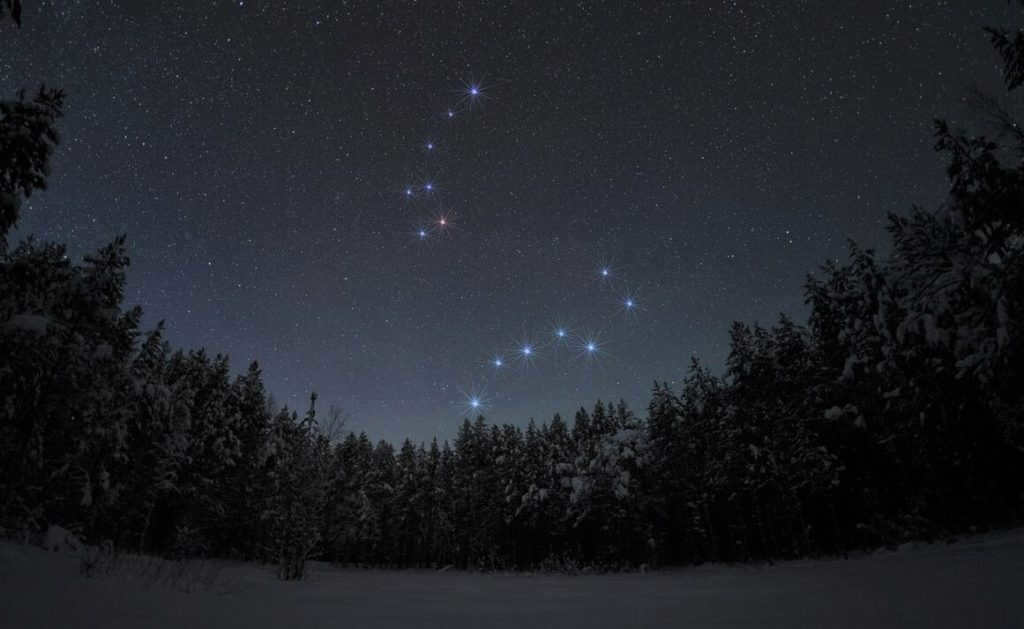
Image of the Big Dipper and the Little Dipper
Locating constellations in the sky can be quite challenging without specialized equipment. However, finding the Big Dipper is relatively easy due to its distinctive shape. Once this asterism is located, the problem is solved.
During late summer and early fall, the Big Dipper can be found in the northern part of the night sky. For optimal viewing, it is recommended to wait until nighttime and venture outside the city to minimize the interference of artificial light from houses and street lamps.
Did you know that it is actually quite simple to determine the north by observing the position of the Sun at noon? Interestingly, at this time, the Sun is actually located on the opposite side of the sky, in the south.
During the autumn season, there is a fascinating asterism that can be seen high in the night sky. This asterism appears to have a horizontal position and consists of stars that are bright enough to be easily noticed by the human eye. Our brain then connects these stars in straight lines, forming a desired object.
Due to the Earth’s rotation around the Sun and its axis, the arrangement of constellations in the night sky gradually changes when observed from a specific point. This means that between the months of January and February, the famous Big Dipper constellation actually undergoes a slow rotation in a circular pattern. The bucket part of the constellation tilts downward, while its handle moves from a horizontal position. Additionally, the overall position of the cluster gradually shifts towards the northeast.
In the springtime, locating the Bucket in the night sky can be quite challenging. During this season, the group of stars known as the Big Dipper finally reveals its “lid up” formation, making it easy to miss for those who are unaware.
The Big Dipper is particularly difficult to spot in the northern regions of Russia. In this area, there are often periods of white nights when the stars are not visible. Additionally, when observing the constellation from the central and southern regions, it is important to note that the Bucket appears with its handle pointing upwards from this viewing angle.
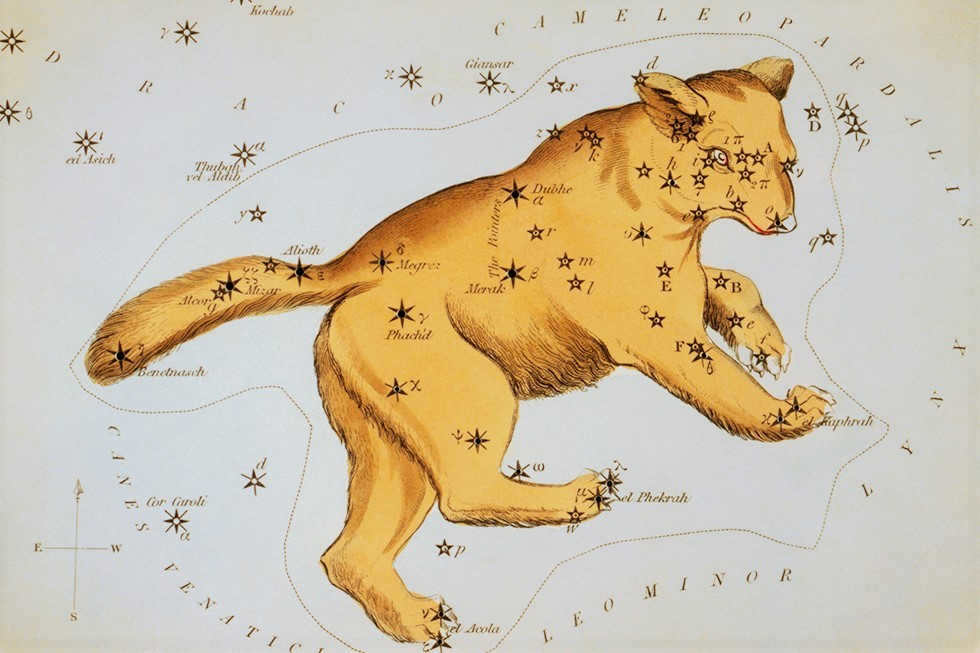

One of the variations of the Big Dipper image on the celestial chart
The Big Dipper is regarded as one of the most ancient constellations, as it is mentioned in almost all civilizations that have ever existed on Earth. The earliest records of this star cluster can be found in India, where it was referred to as “Sapta Rishi” (Seven Sages). This name originated from the seven primary stars that form the Dipper. The Chinese also took note of this constellation and used its position in the sky to determine the time.
According to a beautiful legend, the Greeks had a description of the Big Dipper. It is said that Zeus, known for his attraction to beautiful women, took an interest in Callisto, the daughter of the king of Arcadia. However, Hera, Zeus’s wife, discovered the affair and sought revenge. To protect Callisto from Hera’s anger, Zeus transformed her into a bear and placed her in the sky, where she would be safe.
The Indians also interpreted the figure as a bear, but their version consisted of only four stars arranged in a trapezoid shape. Additionally, they believed that the handle of the Dipper represented three hunters who were chasing the bear. The first hunter, Aliot, was depicted with a bow, while Mitsar carried a cauldron, and Benetnash completed the group with a pile of brushwood for a fire.
Big Dipper’s Stellar Celebrities
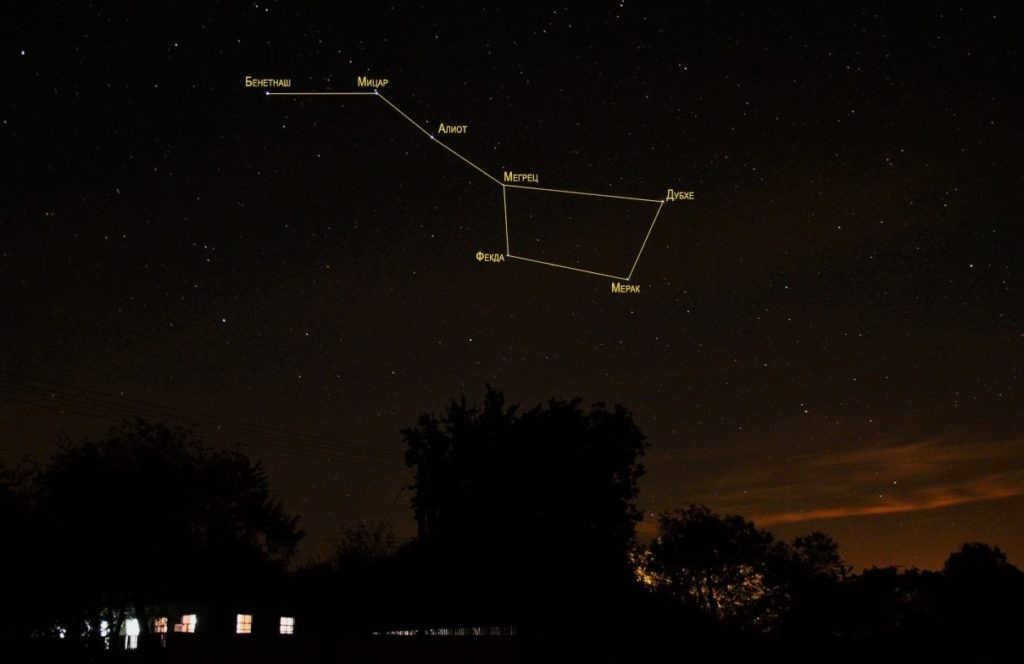
The primary stars of the Great Bear
The Great Bear is comprised of a remarkable array of stars. However, within its asterism, the Dipper, there are merely seven luminaries that form a distinct shape. Advanced technology enables astronomers to continuously observe them and acquire the necessary data. The asterism of the Great Bear includes:
- Dubhe – serving as alpha and being regarded as the second brightest star in the constellation. Thorough investigations have revealed that Dubhe is composed of two luminaries: the main sequence and the orange giant.
- Merak is the beta of the cluster. While not considered the most prominent in the night sky, it shines 69 times brighter than the Sun.
- Fekda is a celestial body situated at the base of the Bucket, beneath the knob.
- Megretz is the least bright star in the Big Dipper.
- Aliot is the most brilliant star in the cluster, easily visible in the sky.
- Mizar is not very visible, unlike the nearby star Alcor, which is nearly twice as bright.
- Alkaid is the farthest luminary from the entire group, located at the tip of the handle of the Bucket.
In addition to the seven stars in the asterism, the constellation contains approximately 125 stars. The human eye can only perceive a few dozen of them. The most prominent ones are the three stars to the right of the Dubhe-Merak pair. They form a triangle. A similar shape can be found in the lower right corner of the Bucket, consisting of the stars: lambda, mu, and psi.
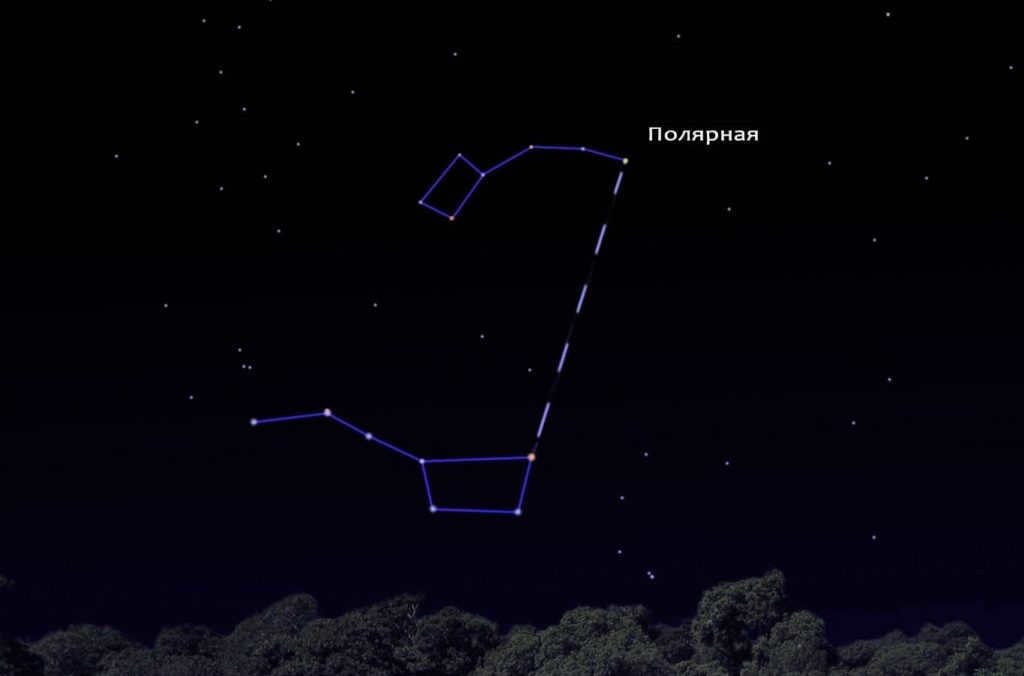
Image of Polaris in relation to the Big Dipper
There are also a few important stars situated to the right of the Big Dipper, with only two shining stars hidden behind the Russian horizon. And since the constellation is always visible in Russia, local astronomers and stargazers can easily locate the following objects:
- Polaris;
- Cassiopeia;
- the Leo constellation is nearby;
- the stars Capella and Arcturus;
- the Gemini constellation;
- the Virgo constellation.
If you know the positioning of these objects in relation to the Big Dipper, you can easily find them.
The assortment of items in the Great Ladle
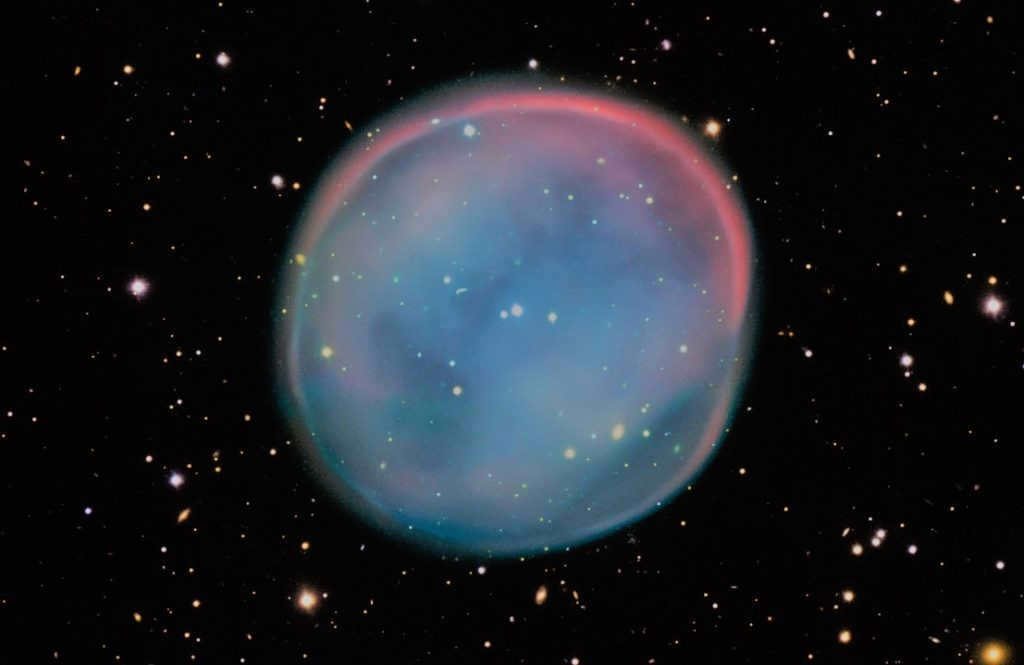
Only the Owl Nebula, also known as M97, is visible in an amateur telescope among the objects of the Big Dipper. The star Merak can be seen next to it.
The region of the night sky where the Big Dipper is located contains around 1,500 galaxies that are of interest to astronomers. Since this cluster is situated within the Milky Way, most of these galaxies can be observed using professional telescopes.
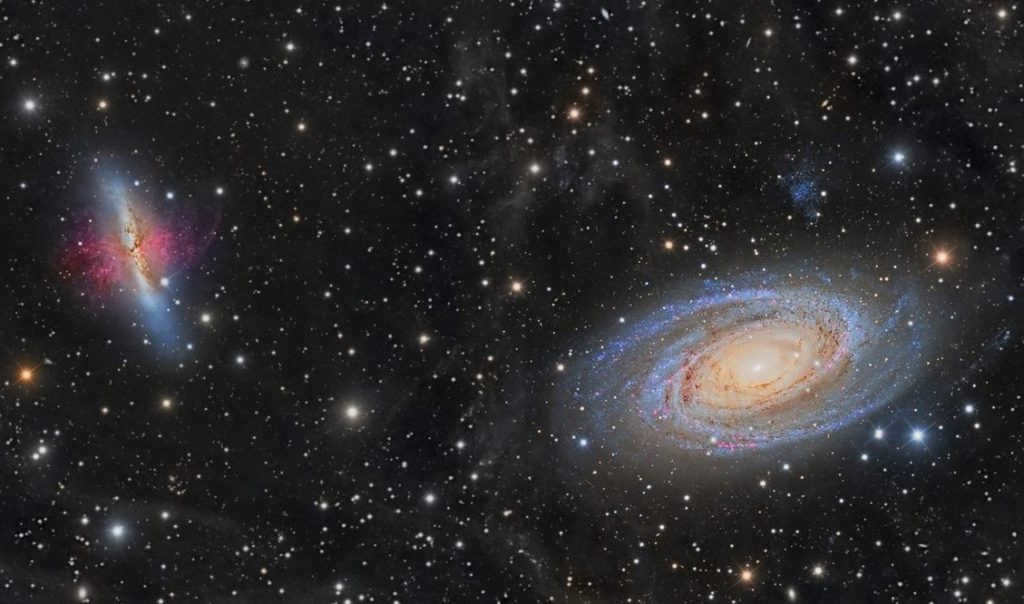
Located 12 million light years away from Earth, the galaxies M82, M81, and M101, also known as Cigar, Bode, and Vertushka, respectively, can be found. One of the most captivating objects in space is the Cigar galaxy, with its violet-blue arms and a distinct blue sphere at its bright center.
With its spiral shape, the Vertuska galaxy boasts long, rounded tails adorned with numerous luminous objects. Astronomers often liken these objects to fireworks, as they resemble exploding bursts of light.
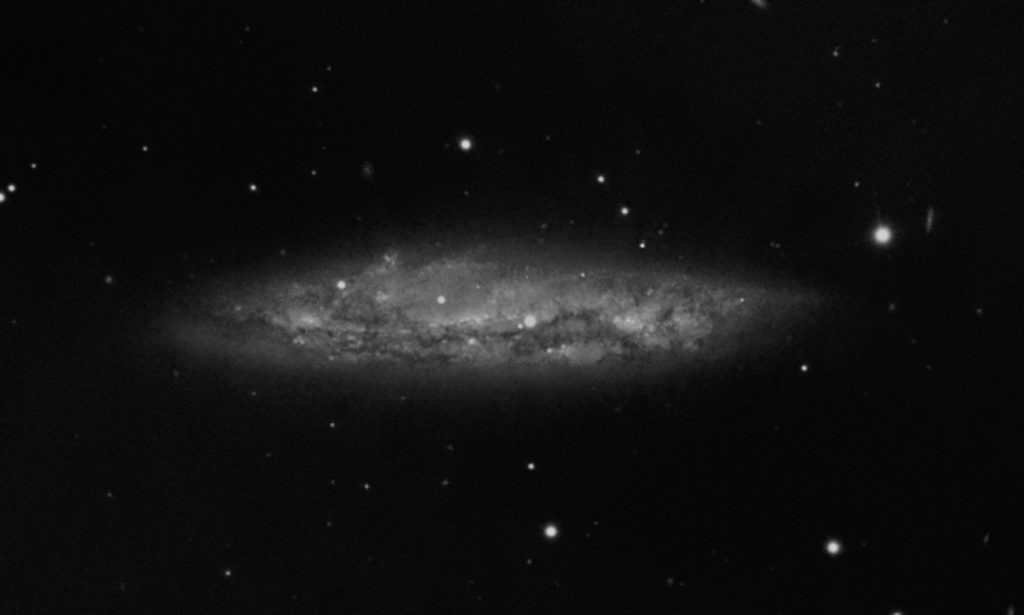
Galaxy M108 can be found near the star Merak. The center of this galaxy is not visible due to dust clouds, which also absorb its brightness. When observed from Earth, its brightness is approximately 12m.
The Dustman galaxy, known as M109, can be seen not far from the Feqda luminary. It is considered one of the most challenging objects to observe as its glow is often overshadowed by stars.
Astronomers regularly discover new galaxies with unique characteristics in the sector where the White Bear is located. Its favorable position in the sky allows for the observation of even the most distant objects.
The Big Dipper during the autumn season
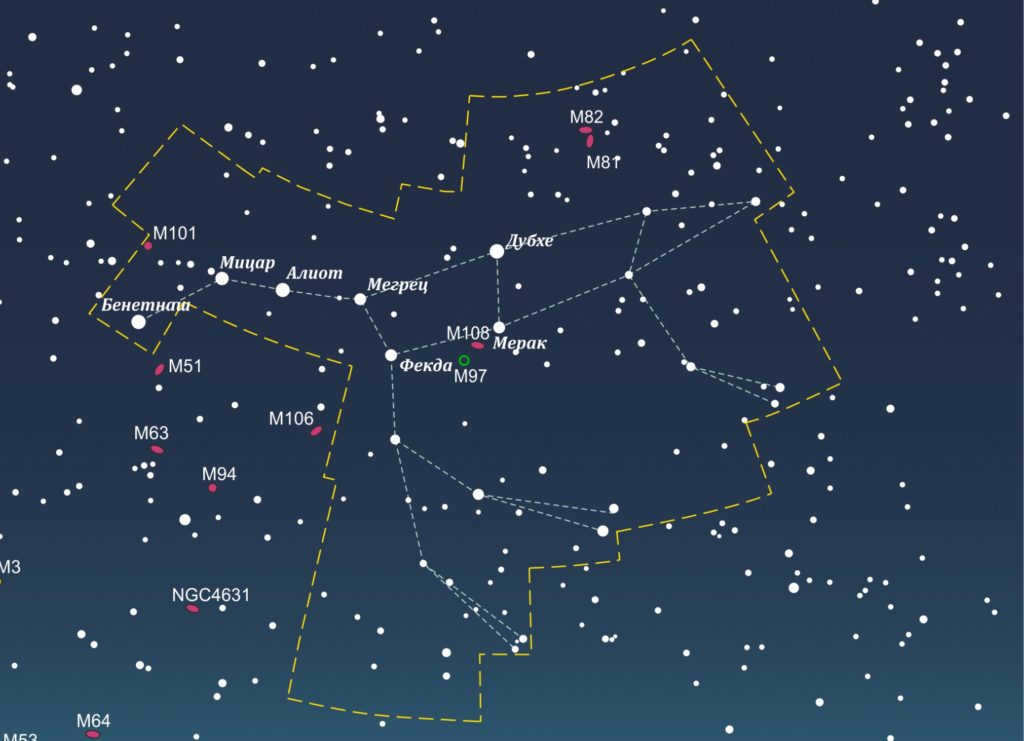
An intricate depiction of the Great Bear constellation
Due to the perpetual movement of celestial bodies, the Great Bear constellation can be found in different parts of the night sky throughout the year. During the autumn months, most stars are concealed from our view. However, the Great Bear’s asterism is an exception to this rule. Although they may not shine as brightly between September and November, its seven prominent stars are visible to the naked eye.
In autumn, the Great Bear can be located in the northern part of the sky, just below Polaris. The constellation appears as a dipper with its handle pointing towards the west. To the east, you can spot the Pleiades cluster, accompanied by the radiant Aldebaran. In the northeast, the prominent stars that form the Gemini constellation are present.
However, not all constellations are visible during the autumn months. Virgo and Leo extend beyond the horizon in Russia, and the Eagle constellation is barely visible from the western region, appearing behind the Big Dipper.
The following constellations are considered the brightest in the autumn sky:
- Orion
- Cassiopeia
- Perseus
- Pegasus
These constellations can be observed at night without the need for special equipment. However, astronomers rely on professional telescopes to observe other celestial objects. These telescopes have enough power to bring stars and galaxies of interest closer. For instance, the Hubble telescope is capable of observing over a thousand galaxies located within the stellar region of the Big Dipper. This allows scientists to continue their work without seasonal breaks or interruptions.
Debunking Misconceptions about the Big Dipper’s Origins
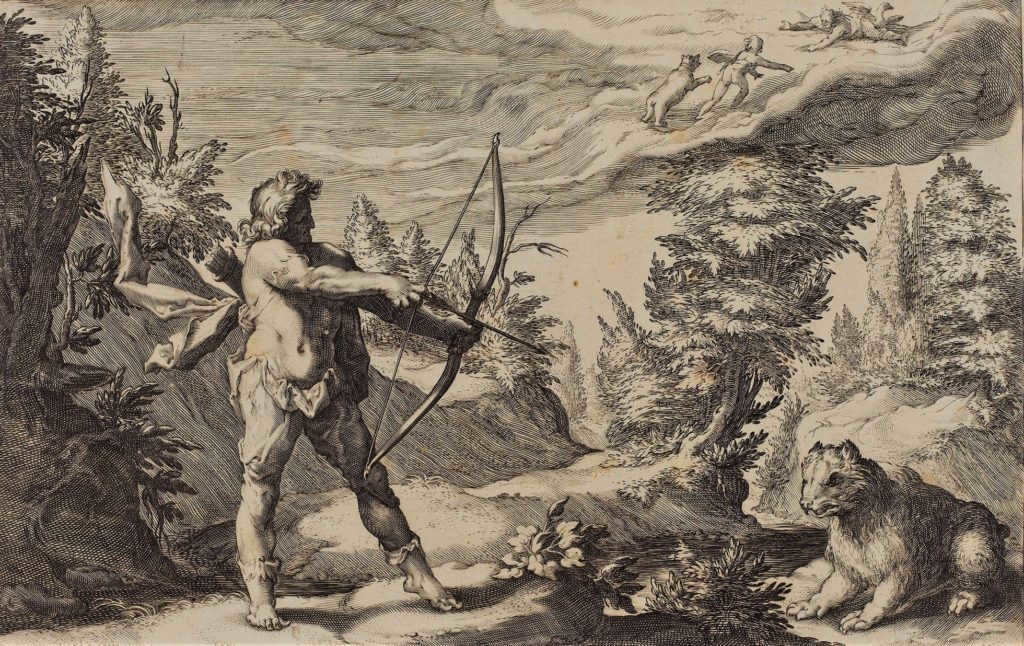
There are multiple stories surrounding the origin of the constellation. One of the most fascinating and well-known is the Greek myth. As previously mentioned, it involves a girl named Callisto, who was the daughter of the king of Arcadia and caught the attention of Zeus.
However, another version of the myth exists. In her youth, Artemis frequently ventured into the forest for hunting expeditions in search of various game. She would bring along young girls of extraordinary beauty as her companions. Callisto stood out as the most radiant among them.
Zeus was drawn to Callisto because of her beauty. In order to win Callisto’s favor, the god disguised himself as Artemis. Eventually, Callisto gave birth to a son named Arcades. Hera, Zeus’s wife, discovered her husband’s actions and angrily transformed Callisto into a bear, giving her an unappealing appearance.
Fun fact: The Big Dipper undergoes a gradual change in shape throughout the year due to the opposite movement of the stars Benetnash and Duhbe compared to the other stars.
What is the optimal moment to witness the Big Dipper?
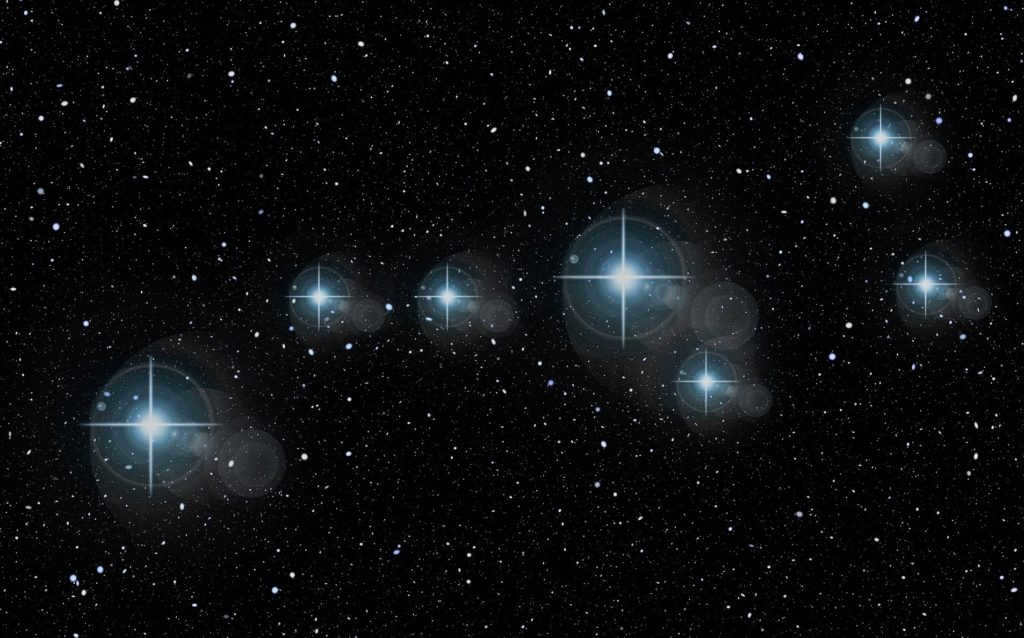
Artificially emphasizing the stars of the Great Bear
To spot the Great Bear in the Russian Federation, one must venture outside of urban areas where artificial light pollution doesn’t obstruct the view of celestial objects. The best time to observe the constellation is between March and April.
During these months, the Great Bear ascends to the highest point in the sky, and each night, around 11:00 PM, the stars reach their peak brightness. By looking up, an individual can easily locate the Big Dipper. With even a pair of amateur binoculars, one can observe not only the seven main stars, but also nearby objects.
The fall is not the ideal season to observe the Big Dipper as it loses its brightness during this time. In order to spot the neighboring stars associated with the constellation, a telescope is necessary.
Using the Big Dipper to navigate
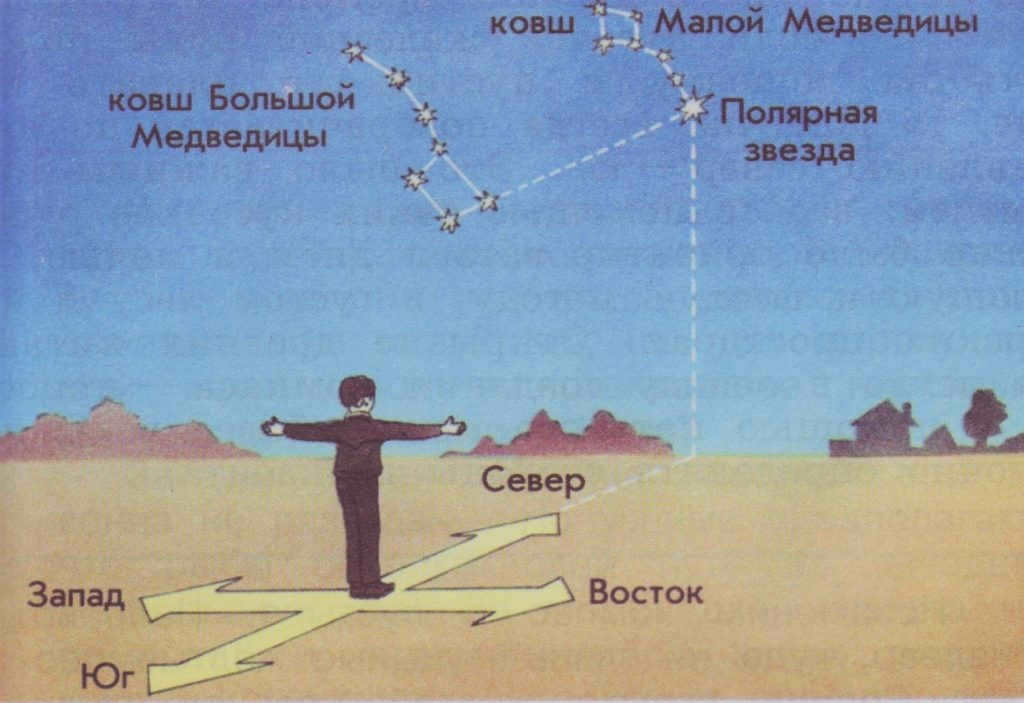
Orienting oneself using the Big Dipper and Polaris
Thanks to its brightness, the Big Dipper has served as a reliable point of reference for people throughout history. Seasoned navigators could use the constellation to determine their position and find their way to the desired direction.
Most importantly, the Big Dipper can help locate Polaris in the night sky. By mentally drawing a straight line from the star to the Earth, one can accurately determine the north using this perpendicular line.
Interesting fact: In ancient Russia, the constellation was known as the Horse due to its distinctive shape. The polar star was seen as a peg to which the animal was tethered.
By identifying the position of the northern direction, one can immediately ascertain the whereabouts of the other cardinal directions: the south lies behind, the west is to the left, and the east is to the right. To aid in spatial navigation, the stars Arcturus and Spica can be found in the southern region. During the Middle Ages, sailors relied on these stars to accurately plot their course while aboard a ship amidst the nighttime sky.
An advantage of using the Big Dipper as a point of reference is that it occupies a significant portion of space. Even in overcast conditions, there is a high probability that at least a portion of the constellation will be visible in the celestial expanse. This alone is sufficient to determine the location of the northern direction.
An Engrossing Video of the Great Bear Constellation
If you happen to stumble upon any inaccuracies, kindly select the problematic text and press Ctrl+Enter.
Estimated Reading Time: 9 minutes
Spread the Word
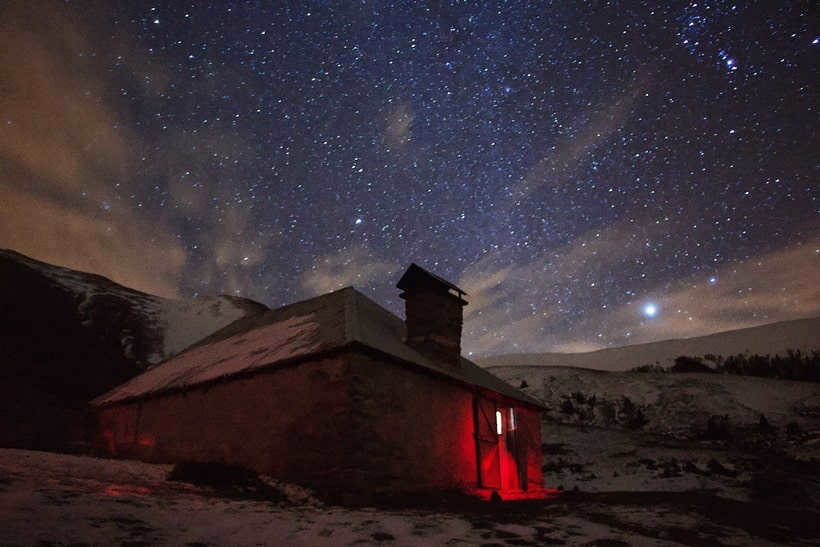
- Natal Astrology
- Relationship Astrology
- Self Development and Psychology
- Predictive Astrology
- Horoscopes and Predictions
- Talismans
- Soul Formula
- Numerology
- Astrological Tarot
- World Astrology
- For beginners
- For professionals
- Development of an Astrologer
Read 9 min
Definition. The Big Dipper refers to a constellation that is widely recognized. It consists of a vast collection of stars and galaxies located in the Northern Hemisphere, making it highly visible in the night sky. Its luminosity has provided assistance in navigation for countless generations.
What should you be aware of? The Big Dipper has been a familiar sight to humans for centuries. It is a fascinating celestial object from an astronomical perspective, but astrologers have also taken note of its significance. In this article, we will discuss the appearance of the Big Dipper in the night sky, the origins of its name, and its unique characteristics.
The Big Dipper – a Prominent Constellation in Astronomy
The Big Dipper is one of the most recognizable constellations in the night sky.
Locating this constellation is quite easy, even without the aid of a telescope, as its stars are exceptionally bright. Throughout history, the Big Dipper served as a guidepost for travelers. Today, scientists still study its unique characteristics, enabling them to uncover new insights into the structure of the universe.
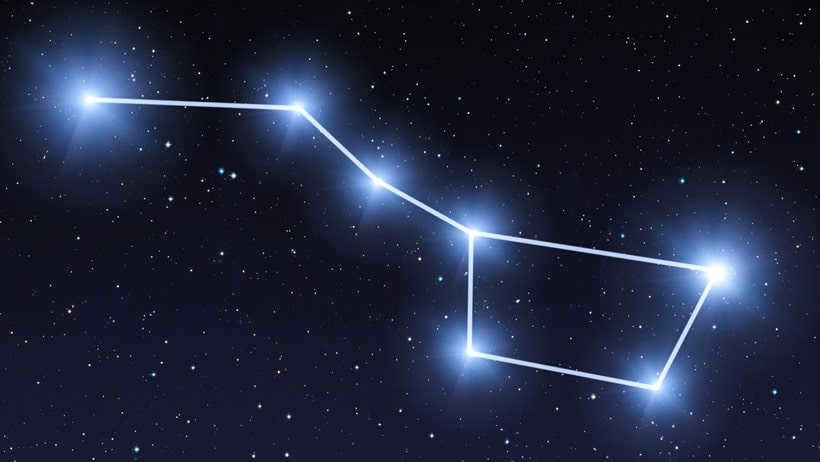
In Latin, the constellation was named Ursa Major – based on this, the abbreviated designation Uma was adopted in 1922.
Only the Hydra and Virgo constellations have a larger area than the Big Dipper. It covers 1279.66 square degrees or 3.1% of the entire starry sky. Throughout the year, this group of stars can be seen in the Northern Hemisphere of the Earth, and only occasionally does it dip below the horizon. This is because its constituent celestial bodies orbit around Polaris, making them easily visible.
The Big Dipper constellation consists of seven of the most prominent stars, which together form the famous “bucket with a handle”.
The adjacent constellations in the celestial sphere include the Draco, Camelopardalis, Coma Berenices, Canes Venatici, Leo Minor, Leo, Ursa Minor, and the North Star.
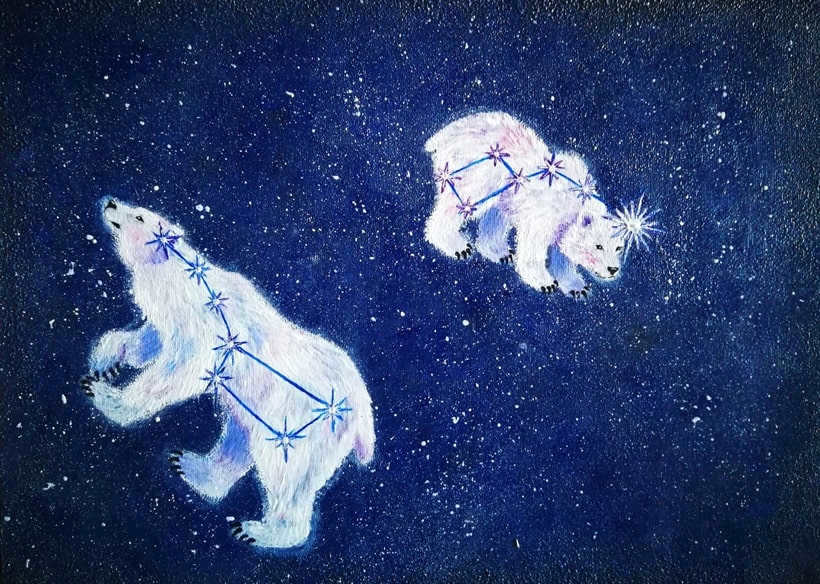

As autumn arrives, the Big Dipper descends towards the horizon – according to Native American beliefs, it is preparing for its winter hibernation. In our country, this constellation can be seen in the sky at any time of the year, but it shines the brightest in April. By understanding the movements of the Big Dipper, one can determine the month and approximate date. Ancient Chinese civilizations were even able to tell time based on the position of the Dipper’s handle.
Deciphering the rationale behind the moniker “Big Dipper” based solely on the constellation’s diagram proves to be a formidable task. In reality, a wider perspective is necessary, as this stellar formation actually encompasses a significantly greater quantity of stars than one might typically comprehend. Entities that lie outside the confines of this celestial cluster exhibit diminished luminosity and can solely be discerned under the conditions of complete obscurity. Alas, in this era of widespread electric illumination, these additional elements remain concealed from our view, leaving us to appreciate the familiar bucket-like configuration.
The most luminous stars in the constellation of the Big Dipper
The response to the query regarding the quantity of stars present in the Big Dipper constellation can be quite astonishing. There are a total of 26 sizable celestial bodies and approximately 125 smaller ones. Nevertheless, the most brilliant ones are the renowned cluster of seven stars that constitute the Big Dipper.
With the aid of cutting-edge technology, astronomers are able to continuously monitor these stars, accumulating fresh information.

Each of these stars has a name in Arabic:
- Dubhe. It serves as the alpha star, being the second most luminous star in the constellation. After conducting extensive research, it was discovered that Dubhe is actually a binary star system, consisting of a main sequence star and an orange giant.
- Merak. It is considered the beta star of the cluster, and its brightness is 69 times greater than that of our Sun.
- Fekda. Positioned at the bottom of the Big Dipper, below the handle.
- Megretz. Regarded as the least bright among the seven stars.
- Aliot. It is the brightest star in the Big Dipper constellation, and can be easily seen in the night sky.
- Mizar. It is challenging to differentiate, as it is in close proximity to the star Alcor, which is twice as luminous.
- Benetnash (Alkaid). It can be found at the tip of the handle of the Big Dipper and is the furthest from the main cluster.
Out of the approximately 125 stars in the Big Dipper, the human eye can only distinguish around two dozen. The most visible ones form a triangle to the right of the pair Dubhe – Merak. In the lower right corner of the Dipper, there is another triangle formed by the stars Lambda, Myu, and Psi.
Interestingly, the shape of the Big Dipper changes gradually throughout the year due to the different motion directions of the stars Benetnash and Dubhe compared to the others.
Objects in the Constellation of Ursa Major
The Ursa Major constellation is home to various celestial objects, not only within our own galaxy but also beyond. These objects include:
The Owl Nebula, discovered by Pierre Mechene in 1781
The Owl Nebula is a notable component of the Milky Way and is classified as one of the largest planetary nebulae. It is situated approximately 2.6 light years away from the Sun. The central star within the nebula possesses a mass that is 70% of the Sun’s mass, while the remaining nebula accounts for about 15%. The surface temperature of this celestial body exceeds 120,000 °K. The composition of the nebula consists of helium, hydrogen, nitrogen, and a significant amount of sulfur.
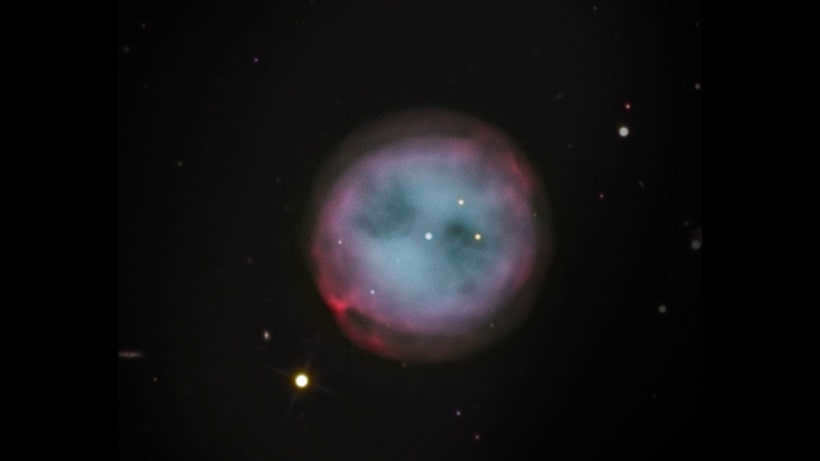
It is believed that the Owl Nebula has an age of approximately 8,000 years. The star has already undergone hydrogen burning in its core, and it is currently undergoing a transition from a red giant to a white dwarf. When the outer shell was expelled in two directions, the nebula developed distinct “eyes” that led to its unique name.
The Bode Galaxy, which was named after its discoverer Johannes Bode in 1774
Situated at a distance of 11.7 million light-years from our planet, it is considered one of the closest galaxies to Earth.
This particular galaxy, which is part of the Big Dipper constellation, exhibits a circular shape with a radius of 35 thousand light-years, and it belongs to the category of spiral galaxies. These galaxies are characterized by their distinct arms that converge towards the center. There is a hypothesis suggesting that the core of this galaxy houses a black hole that is 70 million times more massive than our Sun.
The majority of the radiation emitted by the Bode Galaxy comes from stardust, which is abundantly present in its arms. This characteristic is indicative of active star formation. In total, there are approximately 250 million celestial bodies within this galaxy.
The Cigar Galaxy, a satellite of the Bode Galaxy, is gravitationally linked to the previous galaxy mentioned. The gravitational force affects the hydrogen in both galaxies, resulting in the formation of a “bridge” composed of gas filaments.
The Cigar Galaxy: A Satellite of the Bode Galaxy
Situated 12 million light-years away from Earth, the Cigar Galaxy is a spiral galaxy featuring a prominent central bulge, within which lies a supermassive black hole. This black hole has a mass 3 times 10 to the power of 7 times that of the Sun. However, from our vantage point on Earth, we only observe one side of the galaxy, which explains its name.
The rate of star formation occurring within the central region of the Cigar Galaxy is 10 times more intense compared to that of the Milky Way.
The Vertuschka Galaxy, which was discovered by Pierre Mechene in 1781
The Vertushka Galaxy, which was discovered by Pierre Mechene in 1781, is a spiral galaxy with well-defined arms.
There is another spiral galaxy with well-defined arms. It has a compact bulge at its center, which is a spherical congregation of stars. This distinct feature gives the Vertushka Galaxy a resemblance to the Milky Way. The radius of this galaxy, which is located in the Big Dipper constellation, measures 85 light years. It is situated 20.9 light years away from Earth.
Not only does the Big Dipper constellation contain the Big Dipper asterism, but it also includes a lesser-known asterism called the Three Leaps of the Gazelle. This asterism consists of three pairs of stars, which are:
- Alula North and South (ν and ξ);
- Taniyah North and South (λ and μ);
- Talitha North and South (ι and κ).
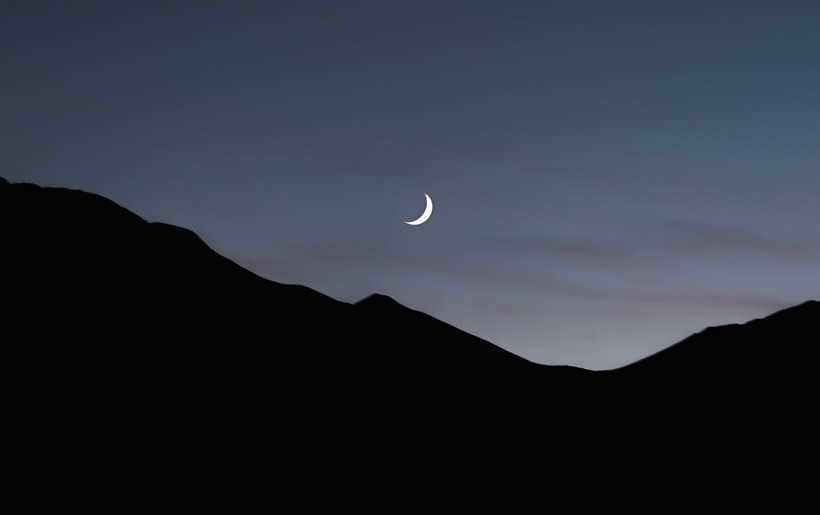
Next to Alula North is the crimson dwarf Laland 21185. While it cannot be observed without specific equipment, it is one of the six nearest stellar systems to the Sun and is even closer than Sirius A and B.
Between the first and second “gazelle jump,” the equipment enables the sighting of a small yellow dwarf known as number 47, which bears resemblance to the Sun. It is recognized to have three exoplanets, large gas giants that orbit around it – studies have been conducted over a period of 10 years, starting in 2000.
This system is among those that most resemble the solar system. NASA placed it 72nd on the list of planets to be examined for similarities to Earth in its planned Terrestrial Planet Finder mission.
The arrangement of stars known as the Big Dipper in the celestial sphere
Most constellations are not easily discernible in the night sky without the aid of specialized tools. However, the unique configuration of the prominent asterism called the Big Bucket makes it a relatively simple task to locate the constellation known as the Big Dipper.
During the late summer and early fall seasons, the Big Bucket can be found in the northern region of the celestial sphere. Optimal viewing conditions for this celestial phenomenon occur in areas away from urban environments, where the brightness from residential and street lighting does not impede visibility.
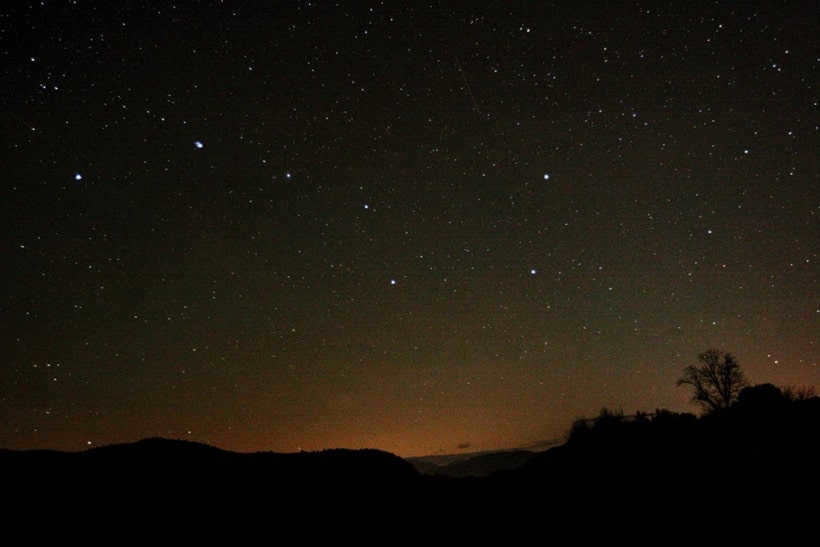
In order to locate the north, one must have knowledge of the Sun’s position at noon – during this time, it can be found in the southern direction. During the autumn season, the Big Dipper can be seen high in the sky, positioned horizontally.
The movement of the Earth around the Sun and its own axis causes a shift in the constellations for an observer situated at the same point on the planet. From the months of January to February, the Big Dipper gradually rotates in a circular motion, with the Bucket transitioning from a horizontal orientation, handle facing downward, to the northeast. In the spring, it becomes particularly challenging to locate in the sky, as the asterism flips backwards and becomes less distinguishable.

Spotting various constellations, such as the Great and Little Bear, in the heavens of northern Russia proves to be quite challenging due to the phenomenon of white nights, when the brightness makes it difficult to observe the stars. For an observer situated in the central-southern region, it is worth noting that the Big Dipper will appear to be pointing upwards.
The Representation of the Big Dipper in Ancient Civilizations
The Big Dipper has been mentioned in some form or another by the oldest known civilizations, according to scientists.
The earliest records of the Big Dipper can be found in India, where it was referred to as the Sapta Rishi, meaning Seven Sages. This name is tied to the number of the brightest stars that comprise the constellation. Chinese scientists were also aware of this constellation and used its position in the sky to tell time.
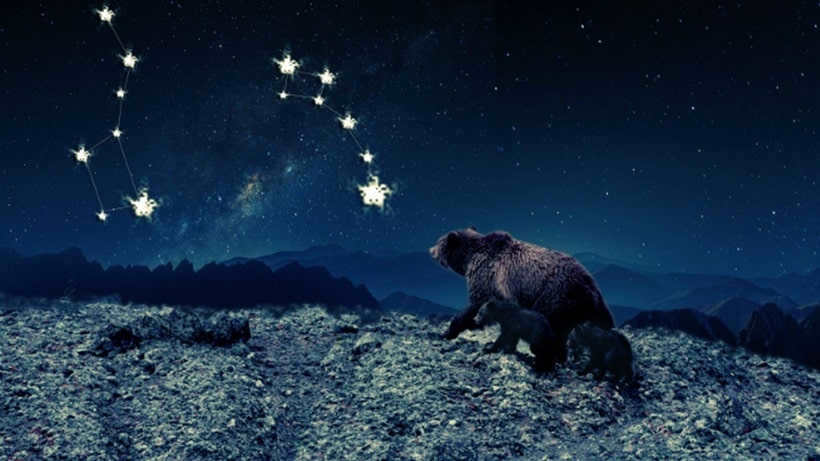
The ancient Egyptians were among the first astronomers, and we now have knowledge of their circular stone “observatories” constructed in the fifth millennium BC. Egyptian researchers were the creators of the constellation system, which later spread to the Middle Ages, Greece, Arab states, and formed the foundation of the current system.
In ancient times, the northern direction was not indicated by Polaris, but by the star Alpha Dragon or Tuban, which can be explained by the Earth’s axis precession. The Egyptians referred to the area surrounding this star and the nearby celestial bodies as the “fixed sky”, which was believed to be the dwelling place of the gods. The constellation Ursa Major was viewed as the leg of Seth, the god associated with war and death, who took the form of a bull. In this form, he fatally struck Osiris with a hoof, resulting in Osiris’ son Horus, depicted with the head of a falcon, severing Seth’s leg.

The constellation of the Big Dipper was one among the 48 constellations recorded in Ptolemy’s star catalog in ancient Greece. This compilation was completed around 140 B.C., and mentions of the Big Dipper can be traced back to the time of Homer.
In accordance with Greek mythology, the Bear represents Callisto, a beautiful maiden who served as a companion to the goddess of hunting, Artemis. Callisto was the daughter of the king of Arcadia. She caught the eye of Zeus, but his wife Hera discovered their affair and sought revenge. To protect the young girl, Zeus transformed her into a bear and placed her in the heavens.
The Native Americans also observed the depiction of a bear in the constellation, specifically consisting of the four stars forming the trapezoid. In contrast, they referred to the handle of the Dipper as the three hunters: Alioth leads the way while holding the bow, followed by Mizar carrying the cauldron, and finally Benetnash carries a bundle of kindling to ignite the fire.
The role of the Big Dipper in astrology
There is a lack of consensus among astrologers regarding the number of zodiac signs. While most agree that there are 12 signs, some argue that there is an additional Serpentine sign located between Scorpio and Sagittarius. Furthermore, there are those who believe that there are actually 24 constellations, with an additional 12 signs in the upper zodiac. These upper zodiac signs differ from the more commonly known lower signs in that they rotate counterclockwise. Individuals born under the upper zodiac signs are said to possess extraordinary abilities, although the specific nature of these abilities is determined by each individual’s unique development plan.
Professional astrology acknowledges the existence of an upper zodiacal circle that overlaps with the regular zodiac. This upper circle connects the periods of the signs in the lower circle. The signs in the upper circle include Serpentine, Clock, Whale, Hunter, Ship, Chariot, Knight, Shepherd, Raven, Tree, Sphinx, and Pegasus.
It is worth noting that constellations have less influence on a person’s personality compared to zodiac signs. If you want to delve deeper into personality traits, it is recommended to utilize Natal Chart parsing.

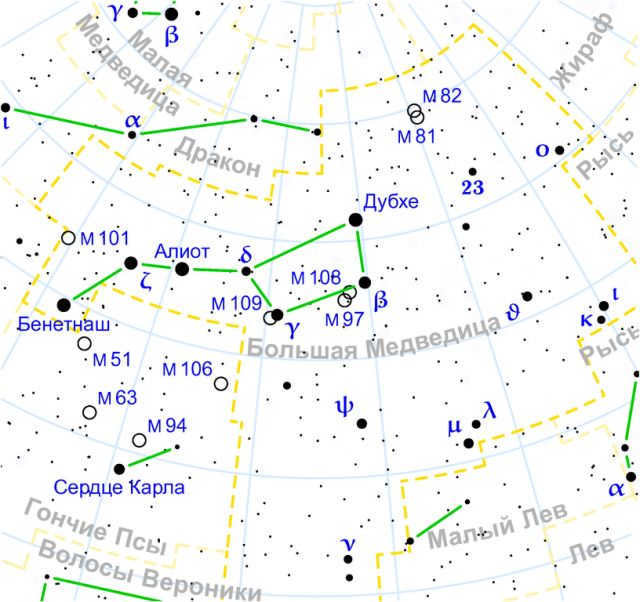
Constellation Ursa Major
Ursa Major is a group of stars located in the northern part of the sky. The seven stars that form Ursa Major resemble a ladle with a handle. The two brightest stars, Alioth and Dubhe, have an apparent magnitude of 1.8. By following the line from the two outermost stars (α and β), you can find Polaris. The best time to observe Ursa Major is in March-April. It can be seen throughout Russia all year round, except for the autumn months in southern Russia, when Ursa Major appears low on the horizon.
Stars and constellations
- Dubhe, also known as the alpha star of the Big Dipper, has the meaning “bear”.
- Merak, which is the beta star, represents “loins”.
- Thekda, the gamma star, symbolizes “thigh”.
- Megretz, the delta star, signifies “beginning of the tail”.
- Aliot, or epsilon, has an unclear meaning, but it is likely related to “curd”.
- Mitzar, the zeta star, can be translated as “girdle” or “loincloth”.
- The final star in the handle of the Big Dipper is called Benetnash or Alqaid, represented by the eta letter. In Arabic, al-qaid banat nash means “leader of the mourners”. This poetic expression is derived from the Arabic interpretation of the Big Dipper constellation.
In the Greek letter designation system for stars, the order of letters corresponds to the sequence of stars.
Another interpretation of the asterism can be seen in its alternative name, The Catafalque and the Mourners. In this perspective, the asterism is likened to a funeral procession, with mourners following a leader and funeral stretchers. This is why the star η of the Big Dipper is referred to as the “leader of the mourners.”
The five inner stars of the Big Dipper (excluding the outermost α and η) actually belong to a single group in space known as the moving cluster of the Big Dipper. This cluster moves across the sky at a relatively fast pace. Dubhe and Benetnash move in the opposite direction, causing the shape of the Big Dipper to change significantly over a span of approximately 100,000 years.
The stars Merak and Dubhe, which create the wall of the Big Dipper, are known as the Pointers because a straight line drawn through them points to Polaris (in the constellation of Ursa Minor). Six of the stars in the Big Dipper have a brightness of 2nd magnitude, while only Megrets has a brightness of 3rd magnitude.
Adjacent to Mizar, which was the second double star discovered through a telescope (by Giovanni Riccioli in 1650; it was likely observed as a double as early as 1617 by Galileo), the sharp-eyed observer can spot the 4th magnitude star Alcor (80 of the Big Dipper). Alcor means “forgotten” or “insignificant” in Arabic. It is believed that the ability to see Alcor has been a recognized test of visual acuity since ancient times. The pairing of Mizar and Alcor is often interpreted as the asterism “Horse and Rider“.
A constellation known as The three leaps of the gazelle is made up of three pairs of stars that are closely spaced and arranged in a straight line. These pairs are separated by equal distances and represent the hoofprints of a gazelle leaping. The stars in this constellation include:
- Alula North and Alula South (ν and ξ, the first leap),
- Taniyah North and Taniyah South (λ and μ, second leap),
- Talitha North and Talitha South (ι and κ, third leap).
The stars Aliot, Mizar, and Benetnash form an arc that points towards Arcturus, the brightest star located north of the celestial equator. Arcturus is also the brightest star visible in the spring in the middle latitudes of Russia. If this arc is extended further south, it points towards Spica, the brightest star in the constellation Virgo.
Laland 21185, a red dwarf situated close to Alula North and not visible to the naked eye, is one of the nearest star systems to Earth, ranking just behind Alpha Centauri, Barnard’s Star, and Wolf 359 in terms of proximity. Another star that can be observed with binoculars is Groombridge 1830, which is only surpassed by Barnard’s star and Kapteyn’s star in terms of its own motion. Over the course of a hundred years, it moves about one-third of the distance across the lunar disk.
The Big Dipper is the third largest constellation in terms of its size, but it is unusually lacking in variable stars. As of 2011, it does not rank among the top ten constellations in this regard.
Other celestial bodies
The Big Dipper region is home to a multitude of galaxies and galaxy clusters. Among them, the spiral galaxy M 101 appears flat, while the spiral galaxy M 81 and the spindle-shaped galaxy M 82, positioned at a close angle of only 38′, are believed to be the nearest group of galaxies to us, located approximately 7 million light-years away. However, the Owl (M 97), which is one of the largest planetary nebulae, is much closer, residing within our own Galaxy. In 2002, astronomers from the University of Texas at Arlington made an intriguing discovery – they found two exoplanets orbiting the star 47 in the Big Dipper. Moreover, in 2001 and 2003, radio messages were transmitted from Earth’s inhabitants to potential extraterrestrial civilizations, specifically directed towards this star.
In October 2013, scientists made an astonishing discovery in the Big Dipper constellation. They found a galaxy called z8 GND 5296 with a redshift value of z = 7.51. This galaxy, which emitted light 13.02 billion years ago, became the most distant one ever detected at that time. Then, on March 1, 2016, another groundbreaking discovery was made in the same constellation. A galaxy named GN-z11, with a redshift value of z = 11.1, took the crown as the most distant object in the universe. The light from GN-z11 traveled a staggering 13.4 billion years to reach us on Earth.
History and Legends
This ancient constellation has a rich history and is surrounded by fascinating myths. Originally, it was believed to be associated solely with the bright asterism known as the Big Dipper. The ancient Greeks had various names for this constellation, including Helica (meaning “shell”), Arctos (meaning “bear”), and Chariot. Among these names, Arctos is considered the oldest, dating back to the times of hunting. According to Greek authors such as Aratus of Soli, who wrote “Apparitions and Predictions” in the 3rd century BC, the constellation was used by ancient Greek sailors for navigation purposes.
One Greek myth tells the story of Zeus transforming the beautiful nymph Callisto into the Dipper, as a way to protect her from the wrath of Hera. Another myth, shared by Philemon of Syracuse, recounts the tale of two Cretan nymphs who were also transformed into bears by Zeus when he was just a baby. Zeus hid them from Cronus and later placed them in the sky as the Big and Little Bears.
Included in Claudius Ptolemy’s Almagest catalog of the starry sky.
The constellation is known as “Sapta Rishi” in Sanskrit, which translates to “Seven Rishis (Sages)”.
Among the nomadic Kazakhs, the constellation is referred to as Zhetikarakshy, meaning “Seven Bandits”. According to legend, Tengri fastened the Iron Peg to the – Temirkazyk (Polar Star), his horses Akboz and Kokboz (stars visible next to it), and seven thieves attempt to steal these horses and are circling around them. Nomads from ancient times relied on the Polar Star (Temirkazyk) for navigation and placed great importance on observing the starry sky.
The Evenks associate the constellation with the image of the cosmic moose Haglan, and in Russian folklore, the constellation is sometimes referred to as “Elk”.
In Chinese astronomy, the constellation known as the Northern Bucket (Beidou) consists of seven stars. Traditionally, the handle of the ladle pointed towards the pole and was used by the Chinese people as a timekeeping tool.
In the culture of the Bashkirs, an ethnic group from Bashkortostan, the constellation is referred to as “Etegәn” in honor of the seven girls depicted in the Bashkir legend “Ete ҡyҙ” or “Seven Girls” in Russian.
Fascinating information
- A remarkable Hubble Ultra Deep Field photograph was captured in an area equivalent to one-twelfth of the lunar disk near the star Megrets. As of 2011, this image remains one of the most intricate depictions of the celestial sky, enabling the identification of numerous galaxies located billions of light years away from our planet.
- Kenshiro, a beloved character from the well-known anime and manga series Hokuto No Ken, proudly bears scars resembling the constellation of the Big Dipper on his chest. Currently, the official Russian translation only includes the standalone three-part novella Fist of the North Star: New Era.
- The world’s inaugural cryo-company has been named after a star found within the constellation of the Big Dipper.
- In his famous work, the renowned Soviet archeologist and historian, academician of the Russian Academy of Sciences B.A. Rybakov, mentioned that the significant constellation in the northern hemisphere known as the Big Dipper was referred to as “Elk” or “Sohatiy” in the Russian North. Similarly, in the Poles, Polaris is called the “Elk star” (Gwiazda Łosiowa). Additionally, the Evenks have their own name for the Big Dipper constellation, referring to it as “Moose Haglen”.
- In the popular animated series Gravity Falls, the protagonist, Dipper Pines, bears a birthmark on his forehead that resembles the shape of the Big Dipper constellation. This birthmark is the reason behind his nickname, Dipper, which is derived from the term “dipper” (also known as the Big Bucket) used to describe the constellation itself.
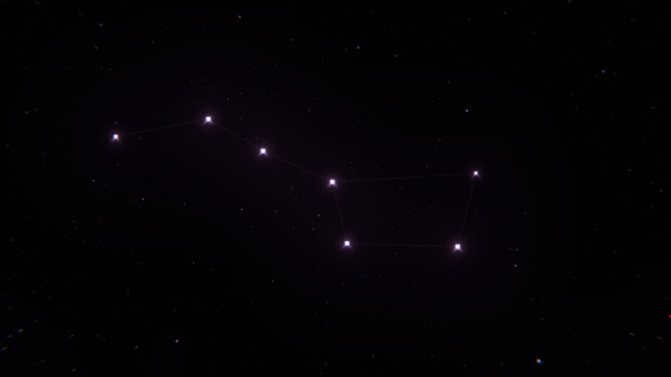
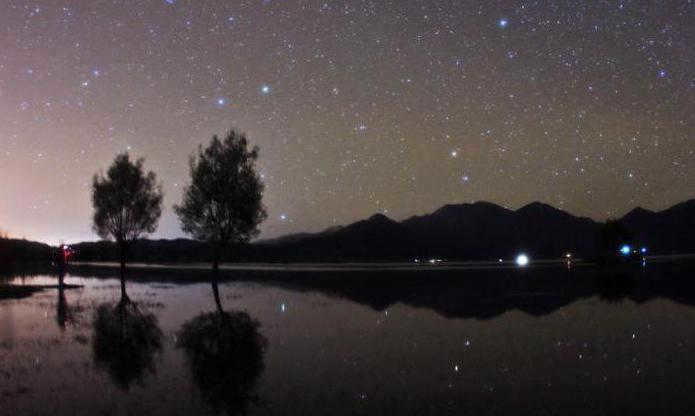
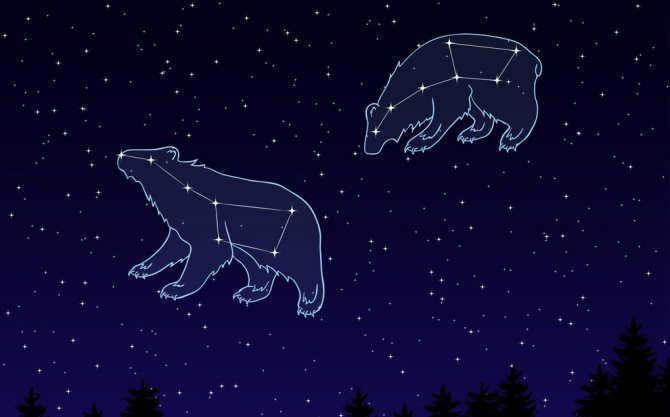
The solution is straightforward: by shifting away from the ladle!
However, the initial step is to locate the dipper itself.
The appearance, description, and features of the Big Dipper
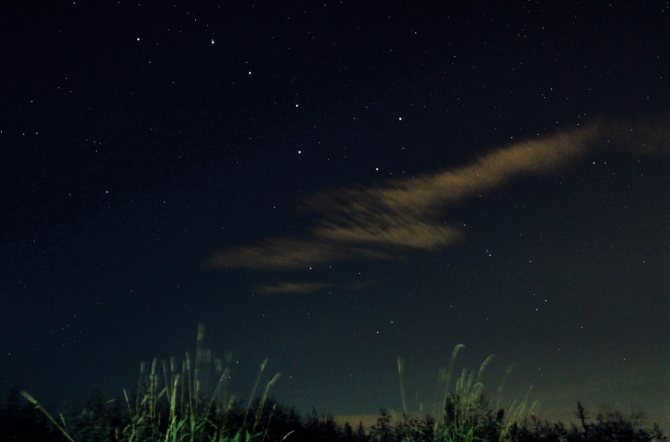
Here is an image depicting the well-known astronomical formation called the Big Dipper, which can be observed in the night sky. The Big Dipper is classified as the third largest constellation in terms of size. It covers more than 3% of the entire celestial sphere and encompasses an area of approximately 1279.66 square degrees. This constellation is notable for its close association with Polaris, the North Star, which ensures that it remains above the horizon throughout the year and is easily visible.
The Big Dipper is composed of seven prominent stars that collectively resemble the shape of a bucket with a handle. In Latin, this constellation is referred to as Ursa Major and is commonly abbreviated as UMa.
There is a vast array of constellations surrounding the cluster. This comes as no surprise, considering its remarkable size. The neighboring constellations include: Draco, Camelopardalis, Coma Berenices, Canes Venatici, and both Leo constellations.
Fascinating fact: As the Big Dipper descends towards the horizon during autumn, there was a legend among Native Americans that this signaled the animal’s preparation for winter hibernation.
In Russia, the constellation is visible year-round, but its stars shine particularly brightly in April compared to other months. The movements of the Big Dipper can be used to determine the month and approximate date. In ancient China, people had the ability to tell time based on the position of the Bucket’s handle.
The Top Seven Brightest Stars
Here we will examine the seven brightest stars of the Big Dipper, ranked in order of their visual stellar magnitude:
Aliot (Epsilon of the Big Dipper)
A subgiant, Aliot is a blue-white star that is relatively close to our solar system, residing just 81 light-years away. With a visual magnitude of 1.75, Aliot is approximately four times more massive than the Sun and twice its diameter. In terms of luminosity, this star shines about 127 times brighter than our Sun.
Dubhe (Alpha of the Big Dipper).
Dubhe, also known as Alpha of the Big Dipper, is an orange giant located 124 light-years away from Earth. It has an apparent stellar magnitude of 1.81, which indicates that it is approximately 415 times brighter than our Sun. Interestingly, Dubhe is not a single star, but rather a double star system. The two stars in this system orbit each other, completing one revolution in 44.4 years.
Benetnash.
This star belongs to the main sequence and has a blue-white color. It is located at a distance of approximately 100 light years from the Sun. With a visual magnitude of about 1.85, Benetnash is six times more massive and 700 times brighter than our Sun.
Mizar and Alcor (Zeta of the Big Dipper/80 of the Big Dipper)
Mizar and Alcor are famous double stars that can be easily observed with the naked eye. They are also known as the Horse and Rider. Both stars have a white color and are located about 80 light years away from us. Mizar has a magnitude of 2.23, while Alcor has a magnitude of 4.01. These stars appear to be very close to each other, and ancient civilizations like the Persians, Romans, and Arabs used the ability to distinguish them as a test for aspiring archers.
Merak.
A white star located approximately 79 light-years away from Earth. It has a stellar magnitude of 2.34 and its radius and mass are about three times that of the Sun. Merak shines 70 times brighter than our Sun.
Fekda (Gamma of the Big Dipper).
Another white star found in the main sequence, Fekda is located approximately 84 light-years away. It has an apparent stellar magnitude of 2.43 and shines about 71 times brighter than the Sun.
Megrez (Delta of the Big Dipper).
Megrez, also known as the Delta star of the Big Dipper, is a dazzling blue-white celestial body. It is located at a relatively close distance, just a stone’s throw away, only 58.4 light-years from Earth. With an apparent stellar magnitude of 3.312, Megrez shines brightly in the night sky. This magnificent star is 63% more massive than our sun and radiates an impressive brightness that is 14 times greater.
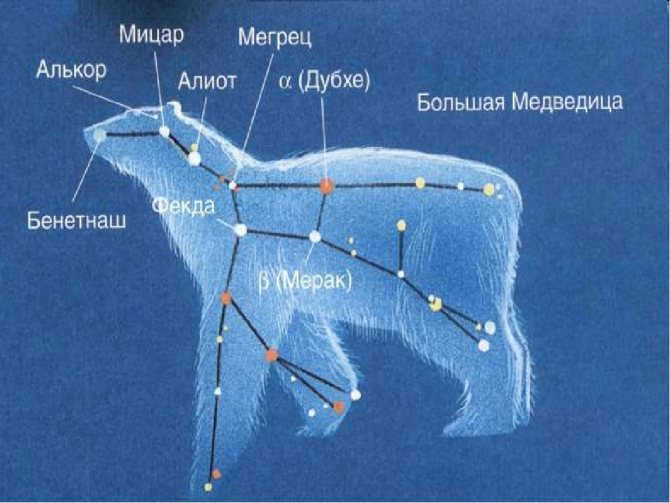
The stars that shine the brightest can be found in the constellation known as the Big Dipper. This information has been gathered from reliable public sources.
Where can one locate the Big Dipper in the celestial sphere?
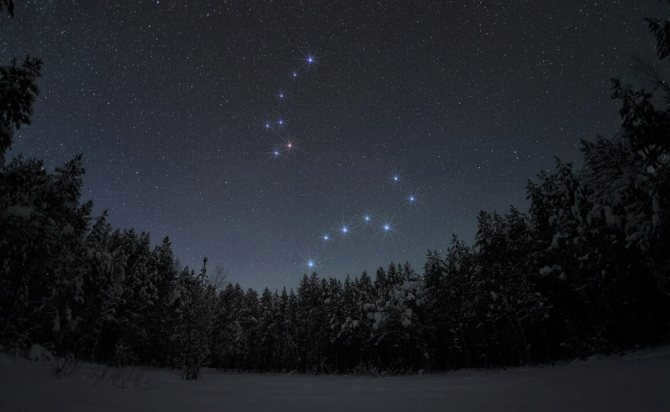
The image depicts the Big Dipper and the Little Dipper constellations. Locating constellations in the night sky can be a challenging task without the aid of specialized equipment. However, identifying the Big Dipper is relatively easy due to its distinct shape. Once a person locates this asterism, they can easily determine their position.
During late summer and early fall, the Big Dipper can be found in the northern part of the night sky. For optimal observation, it is recommended to wait until nightfall and venture outside urban areas to minimize light pollution from buildings and streetlights.
Fascinating fact: One can easily determine the direction of north by observing the position of the Sun at noon. The star will be located in the southern part of the sky at this time.
During autumn, the asterism can be seen high in the night sky, positioned horizontally. The stars that make up the asterism are bright enough to be easily visible to the naked eye, and our brain naturally connects them to form the desired object.
As the Earth orbits the Sun and rotates on its axis, the arrangement of constellations in the night sky gradually changes from different vantage points. This means that between January and February, the Big Dipper slowly rotates in a circular motion: The bucket portion tilts downward while the handle remains in a horizontal position. Additionally, the overall position of the cluster gradually shifts towards the northeast.
During spring, it becomes more challenging to locate the Big Dipper in the night sky. At this time, the asterism appears to be “lid up”, making it less noticeable to individuals who are not familiar with its usual orientation.
Fascinating: What is the reason behind the cosmic darkness? Detailed explanation, captivating visuals, stunning imagery, and an engaging video await you.
To make matters worse, the Ursa Major constellation, commonly known as the Big Dipper, is easily visible in the northern regions of Russia. Unfortunately, these areas frequently experience the phenomenon of white nights, which makes it impossible to see the stars. Additionally, it should be noted that when observing this constellation from the middle and southern latitudes, the Big Dipper appears with its handle pointing upwards.
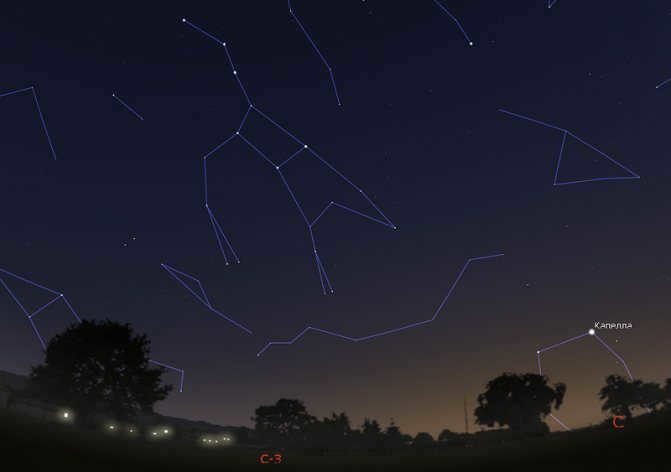
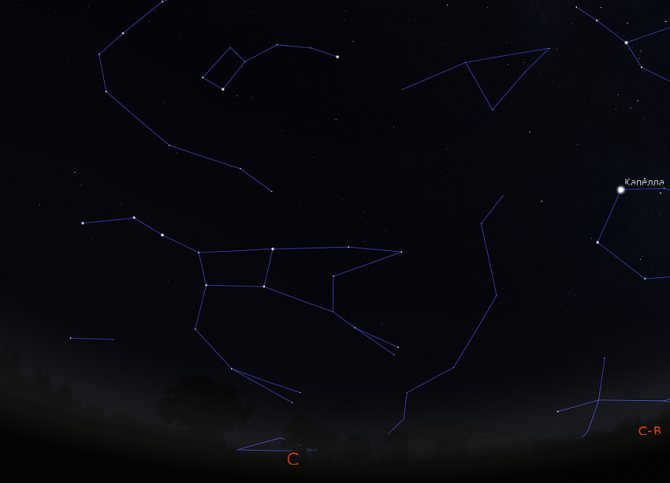
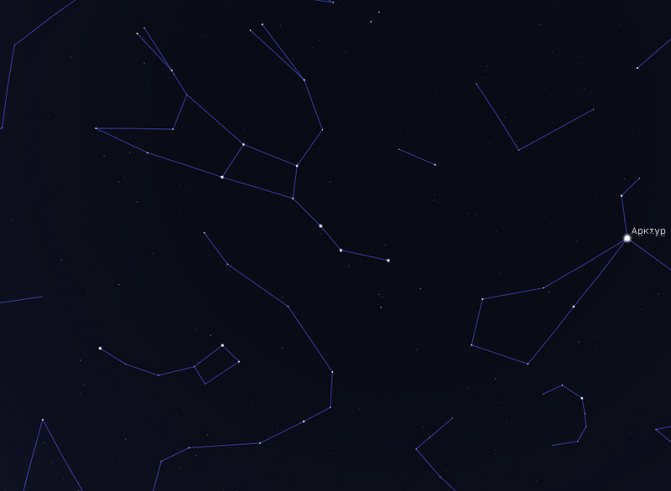
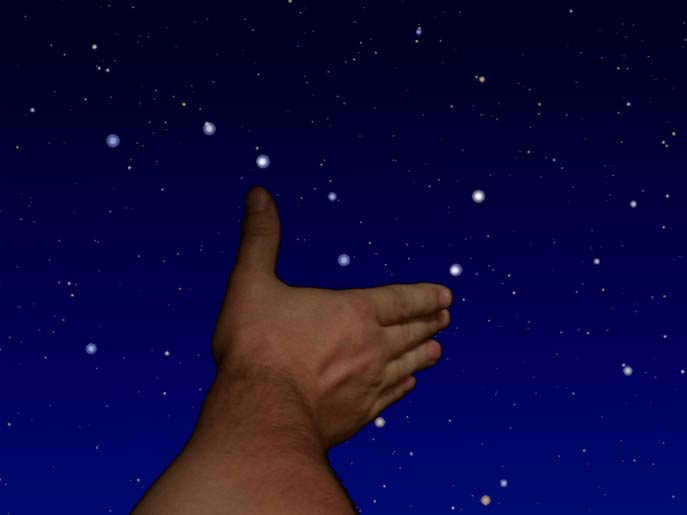
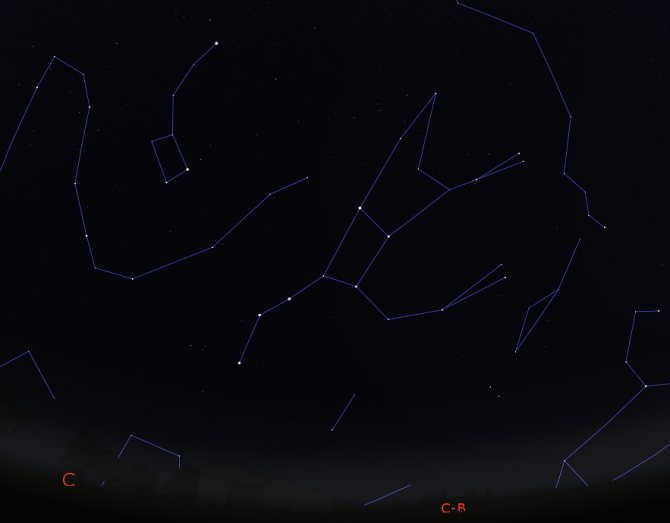
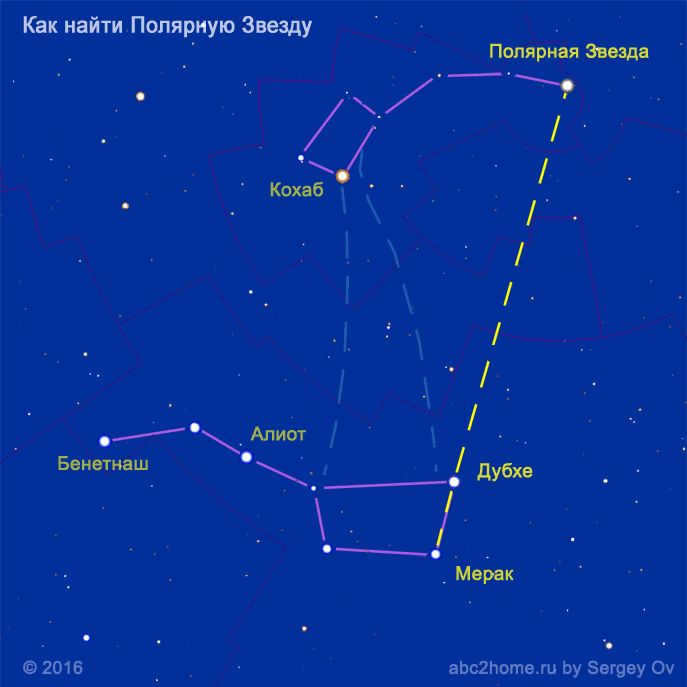
There exists an ancient Greek legend that explains the origin of the name “Big Dipper” for the constellation.
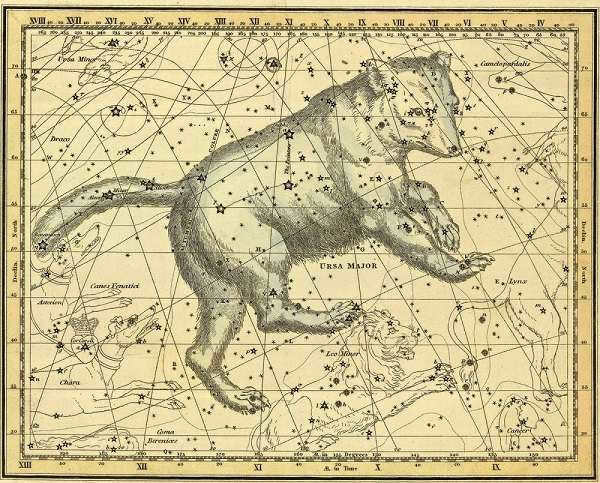
One of the nymphs who served Artemis was Callisto, the daughter of King Lycaon, known for her exceptional beauty. Zeus, captivated by her allure, disguised himself as Artemis and seduced her. When the goddess discovered Callisto’s pregnancy, she became enraged and banished her from her presence. Callisto, filled with sorrow, sought refuge in the mountains, where she gave birth to her son, Arkas.
However, the nymph’s series of unfortunate events did not end there. Hera, the wife of the god who seduced her, discovered Arkas, Zeus’ illegitimate child, and as an act of revenge, transformed her rival into a bear. When Arkas grew up, he took on the hobby of hunting. One day, while in the mountains, he came across a bear, completely unaware that it was his own mother standing before him. The young man aimed his bow at the creature, but Zeus intervened and prevented him from doing so.
The supreme deity couldn’t allow his son to commit such a terrible act, but he was unable to break the curse placed upon Callisto by Hera. Feeling sympathy for the unfortunate Callisto, Zeus transformed both her and her son into stars, sending them to the heavens. Thus, the constellation Ursa Major, also known as the Big Dipper, appeared in the night sky, alongside her son Ursa Minor, or the Little Dipper.
Ancient Observers’ Perspective on the Big Dipper
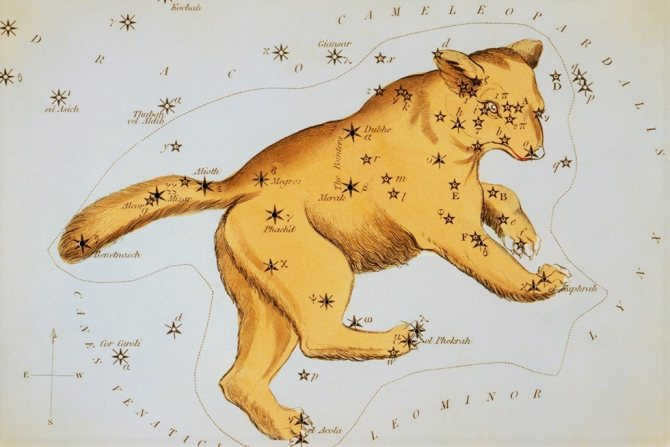
The Big Dipper is known by different names in various cultures and is considered one of the oldest constellations. It is mentioned in records dating back to ancient India, where it was called “Sapta Rishi” meaning “seven sages” due to the seven main stars that form the constellation. The Chinese also observed the Big Dipper and used its position in the sky to determine the time. Throughout history, the Big Dipper has been recognized and studied by civilizations around the world.
The ancient Greeks had a fascinating story to explain the formation of the Big Dipper. Legend has it that Zeus, the king of the gods, had a penchant for beautiful women. One such woman was Callisto, the daughter of the king of Arcadia. When Zeus’s wife Hera discovered the affair, she sought revenge. To protect Callisto from her wrath, Zeus transformed her into a bear and placed her in the sky, where she would be safe from harm.
Similarly, the Indians also saw a bear in this constellation, but their interpretation differed slightly. According to their beliefs, the bear is represented by four stars arranged in a trapezoid shape. The handle of the Big Dipper is then depicted as three hunters chasing the bear. The first hunter, Aliot, is depicted holding a bow, while Mitzar carries a cauldron. The group is completed by Benetnash, who carries a pile of brushwood to start a fire.
The Mysteries of the Big Dipper: Various Cultural Interpretations
Ancient Egypt’s “Bull’s Thigh”
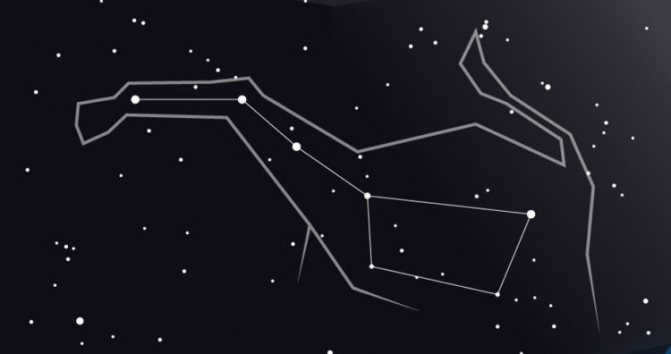
China’s "Imperial Carriage of Emperor Shandi".
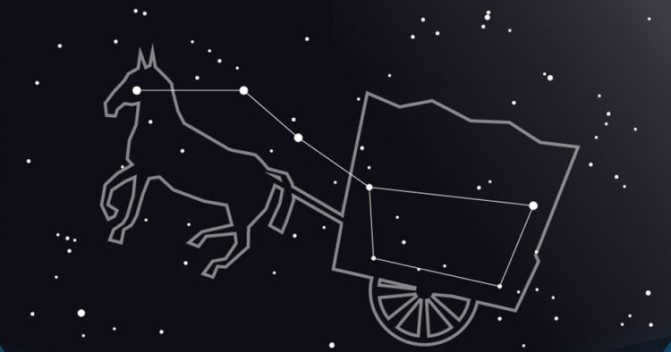
Ancient Chinese astronomers had a unique way of dividing the sky, using 28 vertical sectors known as “houses.” These houses represent the path of the Moon during its monthly journey. This system is similar to Western astrology, where the Sun passes through the signs of the Zodiac on its yearly rotation. The Egyptians originally introduced the 12-sector division, which was later adopted by Western astrology. In the center of the sky, the Chinese considered Polaris as the emperor, much like the ruler of a state capital. Polaris had already assumed its usual position by that time. The seven brightest stars of the Big Dipper are located near Polaris within the Purple Enclosure. This enclosure is one of the three surrounding the palace of the “royal” star. These stars can be referred to as the Northern Bucket, as they correspond to the seasons’ orientation. Alternatively, they can be seen as part of the carriage of the Heavenly Emperor Shandi.
Seven Wise Men of India
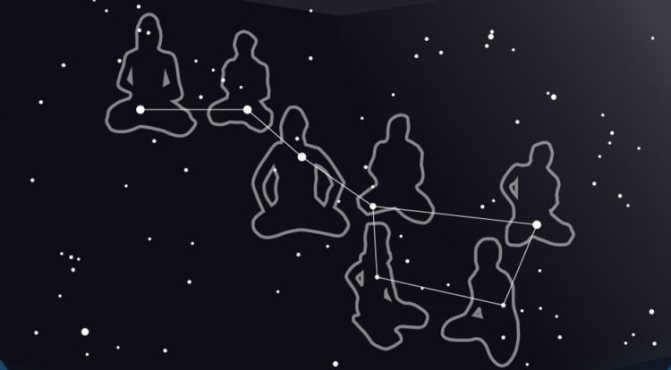
Ancient India did not witness the same level of advancement in observational astronomy as it did in mathematics. Its concepts were heavily influenced by both Greece and China. For instance, the 27-28 “stands” (nakshatras) that the Moon traverses in approximately a month bear a striking resemblance to the Chinese lunar “houses”. The Hindus also assigned great significance to Polaris, which, according to the Vedic experts, serves as the abode of Vishnu himself. The constellation known as the Bucket, situated below Polaris, was believed to represent Saptarisha – the seven sages who were born from Brahma’s mind and are considered the ancestors of our current era (Kali-yuga) and all beings inhabiting it.
The Greek constellation commonly known as the “Big Dipper.”
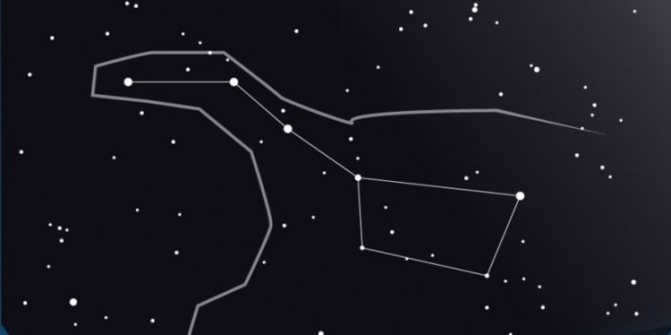
The constellation known as the Big Dipper is included in Ptolemy’s star catalog from around 140 BC, although it is mentioned even earlier, dating back to the time of Homer. There are various conflicting Greek myths that explain its origin, but they all agree that the bear represents Callisto, a beautiful companion of the goddess-hunter Artemis. In one version of the myth, the mischievous Zeus used his usual tricks to seduce Callisto, which angered his wife Hera and Artemis. To protect his lover, Zeus transformed her into a bear, and she roamed the mountain forests for many years until her own son, who was fathered by Zeus, found her while hunting. Once again, the supreme god had to intervene, and he brought them both to the heavens to prevent any harm from coming to them.
America’s Majestic Grizzly
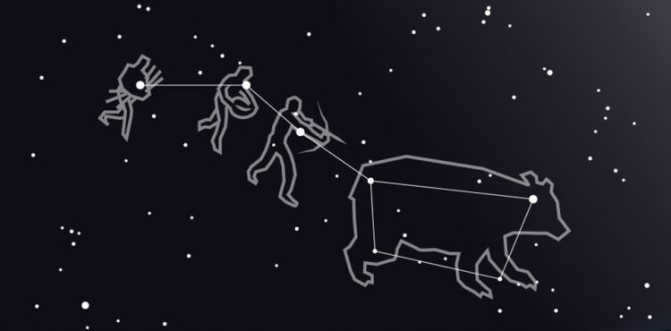
The Native Americans seemed to have a deep understanding of the natural world, as evidenced by the Iroquois legend explaining the origin of the constellation known as the “Big Dipper”. According to this legend, the celestial bear depicted in the constellation does not have a tail. Instead, the three stars that make up the handle of the Dipper represent three hunters who are in pursuit of the bear. Aliot is depicted as drawing a bow with an arrow already embedded in it, Mitzar is shown carrying a cauldron for cooking the bear’s meat (known as Alkor), and Benetnash is depicted carrying an armful of kindling to light the hearth. As autumn arrives and the Dipper sinks low on the horizon, it is said that blood from a wounded bear drips down, staining the trees with a beautiful array of colors.
Big Dipper’s Stellar Cast
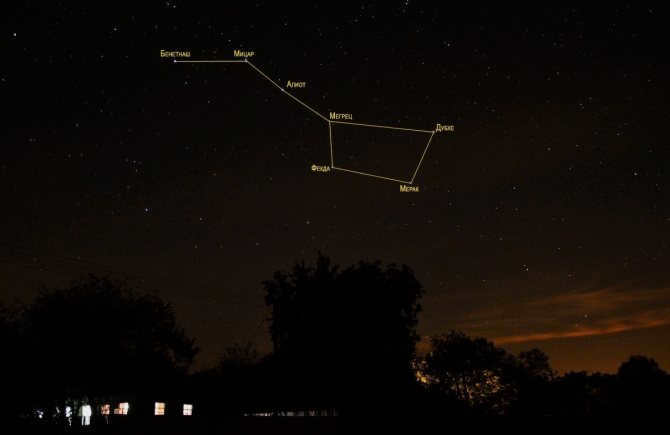
The primary stars of the Great Bear
The Great Bear is comprised of a substantial number of stars. However, within its asterism, the Dipper, there are only seven luminaries that form a distinct shape. Modern technology enables astronomers to continuously observe these stars and gather the necessary information. The asterism of the Great Bear consists of:
- Dubhe – serves as the alpha and is considered the second brightest star in the constellation. Thorough studies have revealed that Dubhe is composed of two luminaries: the main sequence and the orange giant.
- Merak is the beta of the cluster. Although not regarded as the most prominent in the night sky, it shines 69 times brighter than the Sun.
- Fekda is the luminary situated at the bottom of the Dipper, below the handle.
- The faintest star in the Big Dipper is Megretz.
- Aliot is the most visible and brightest star in the cluster.
- Mizar is not very visible because the nearby star Alcor is almost twice as bright.
- Alkaid is the most distant luminary from the overall group, located at the end of the handle of the Bucket.
In addition to the seven stars in the asterism, the constellation contains approximately 125 other stars. Only a few dozen of them can be seen with the naked eye. The three most prominent stars are located to the right of the Dubhe-Merak bundle and form a triangle. In the lower right corner of the Big Dipper, there is another triangle made up of the stars lambda, mu, and psi.
Fun fact: In some cultures, these two triangles are said to represent the hind and front paws of a bear.
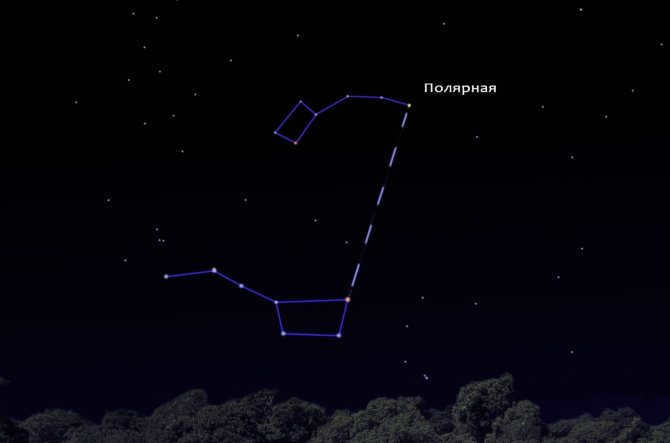
Image of Polaris with respect to the Great Bear constellation
In addition, there are several prominent stars situated to the right of the Big Dipper, with only two stars hidden below the horizon in Russia. Since the constellation is always visible in the Russian Federation, local astronomers and enthusiasts of stargazing can easily locate the following celestial objects:
- Polaris;
- Cassiopeia;
- the Leo constellation is nearby;
- the stars Capella and Arcturus;
- the Gemini constellation;
- the Virgo constellation.
Interesting fact: The largest planet in the solar system – description, structure, photos, and video
If you know the direction in which these objects are located relative to the Big Dipper, they can be easily found.
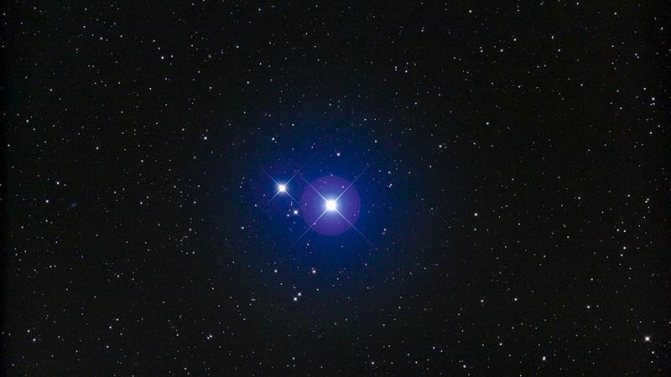
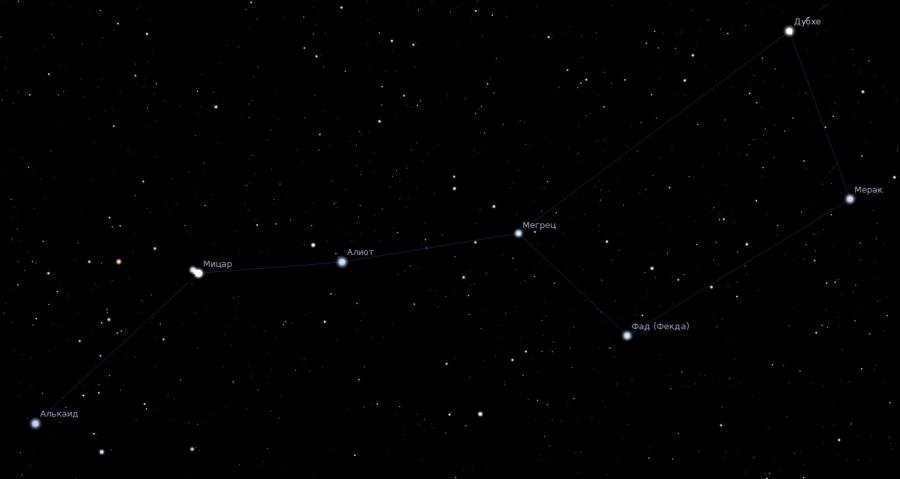
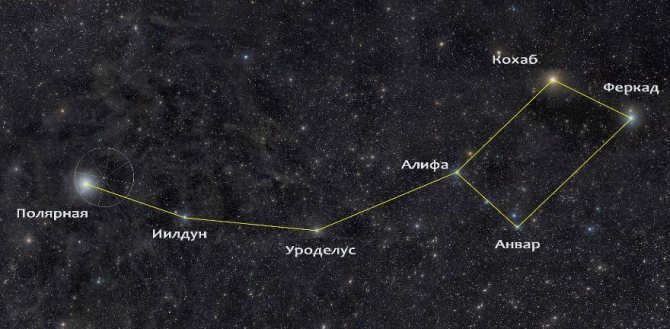
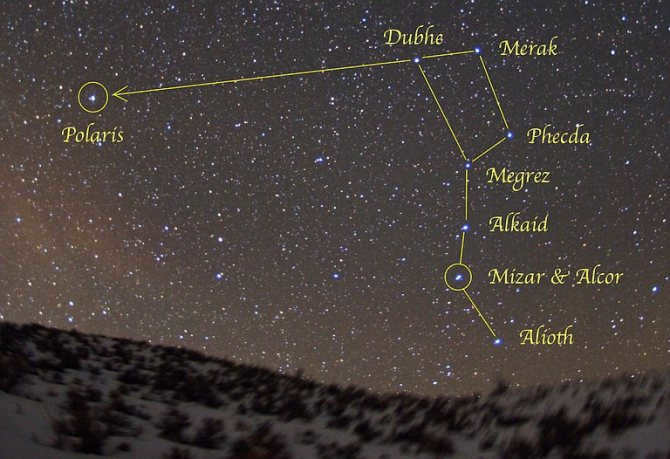
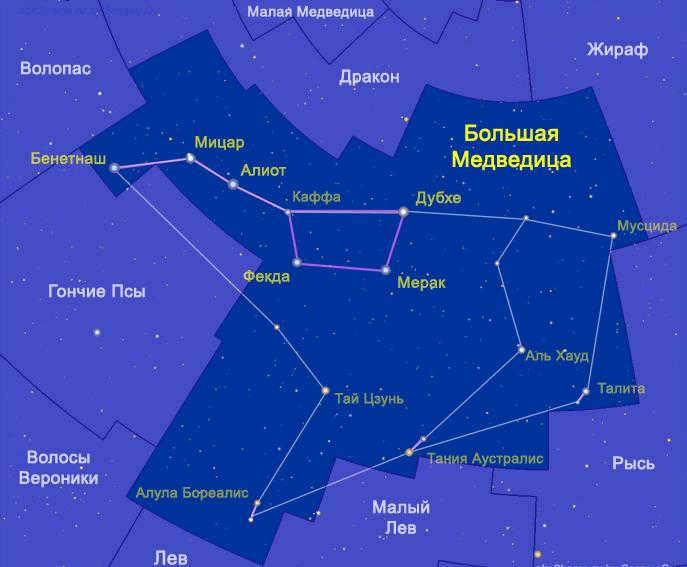
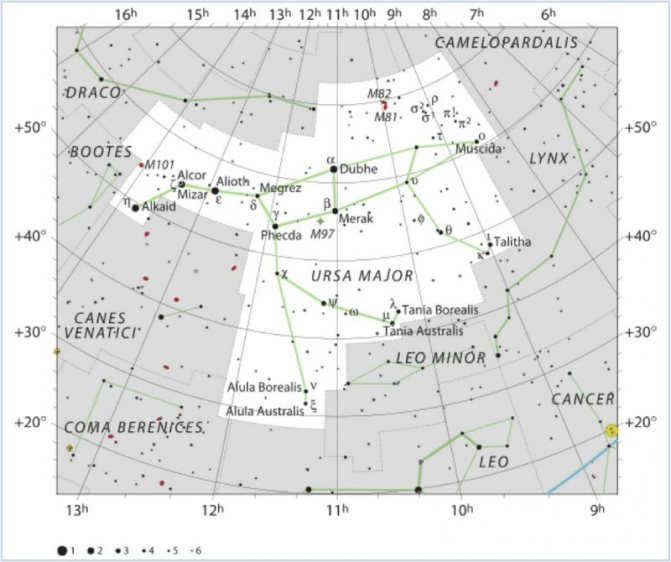
The constellation of the Big Dipper and the Little Dipper in the starry sky are rightfully considered the most famous and recognizable of the cluster of stars in the northern hemisphere. As we know from our youth, the stars of the Big Dipper form a dipper in the sky – luminaries of recognizable shape and with an established name. Such a cluster of nocturnal, celestial bodies rightfully has the third place in its magnitude. The first positions are occupied by such constellations as Virgo and Hydra. In total, there are 125 stars in the Big Dipper. All of them can be distinguished with the naked eye. The bucket is formed by seven of the brightest stars. Each of them has its own name.
Now let’s direct our attention towards the constellation of the Big Dipper. It is impossible to envision the realm of outer space without it. Among the stars of this cluster, we can identify:
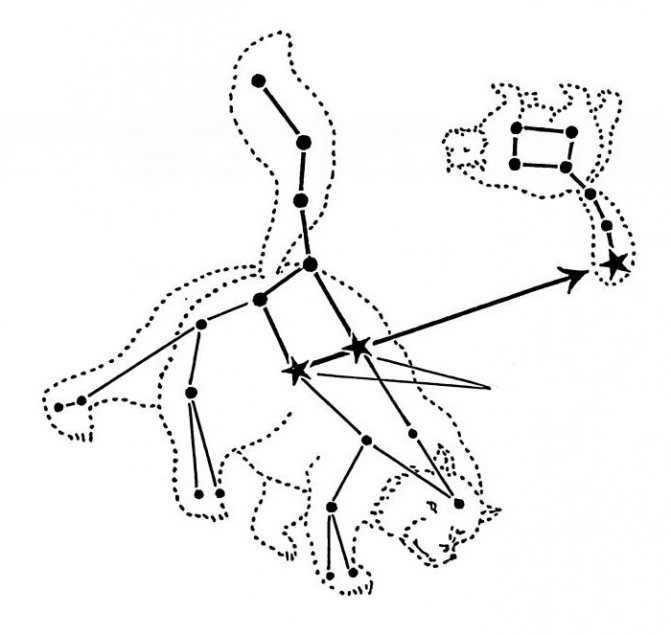
The star known as Dubhe is commonly referred to as the “bear” and it is the brightest star in the Big Dipper. Merak, the second brightest star, translates to “loins.” Fekda means “thigh,” Megretz means “beginning of the tail,” Aliot means “curd,” Mitzar translates as “loincloth,” and Benetnash literally means “leader of the mourners.”
These are just a few examples of the many stars that form the well-known cluster.
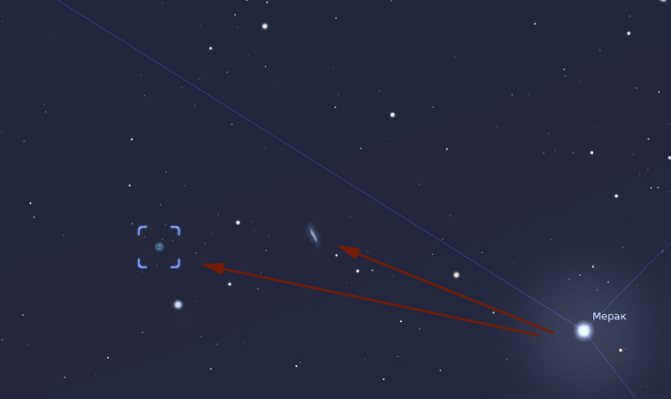
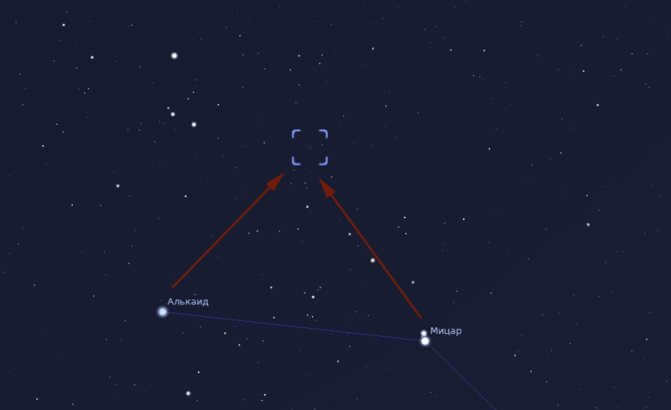
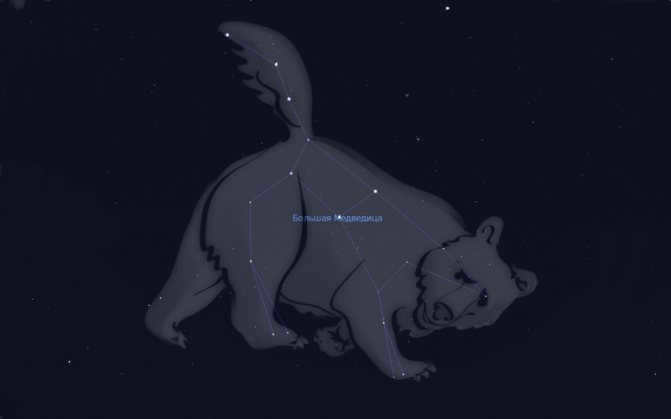
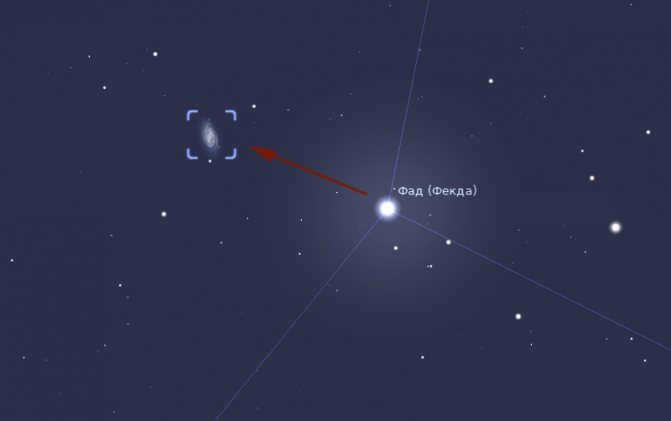
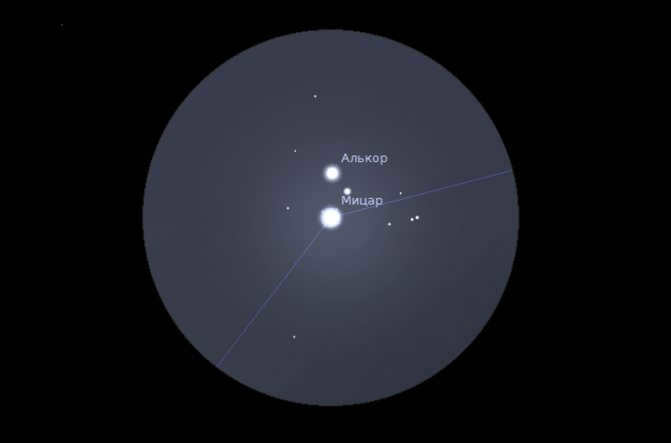

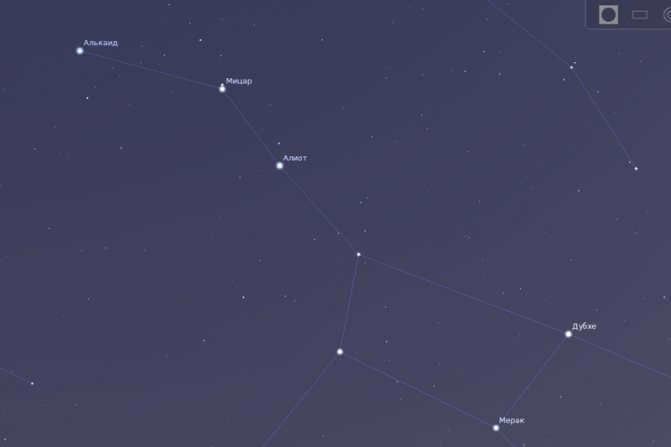
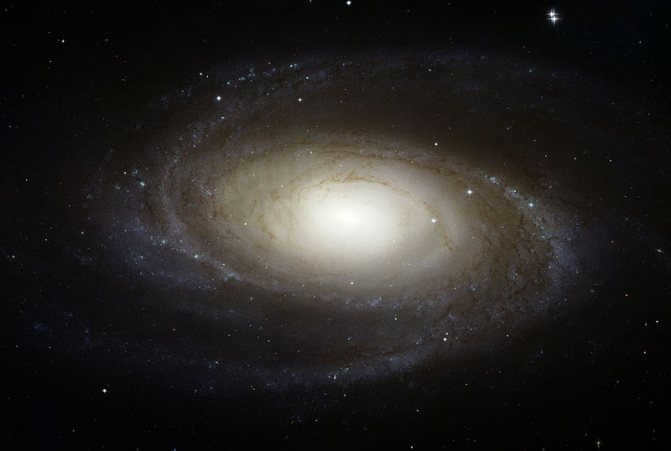

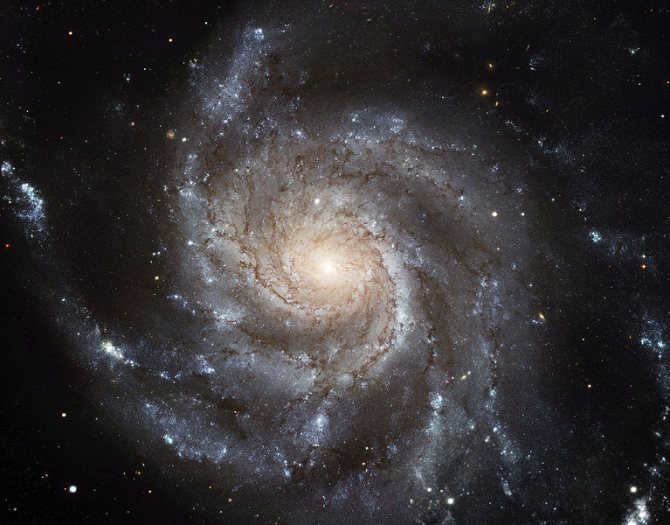
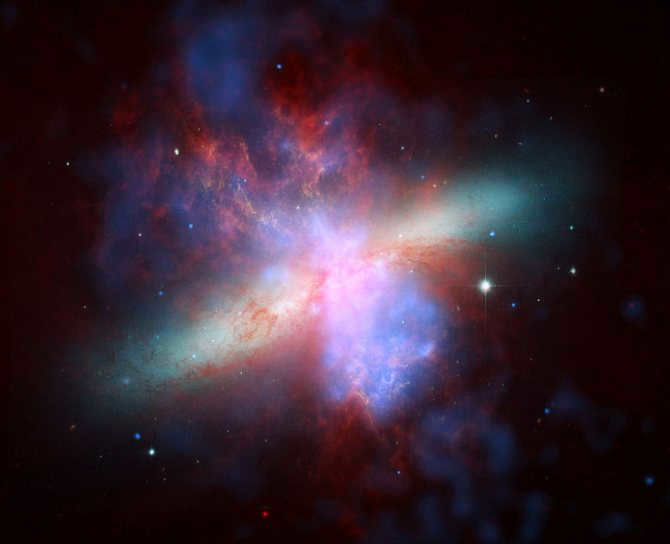
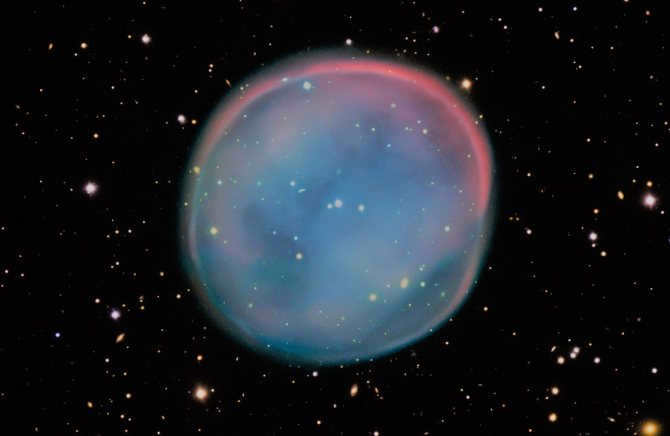
The Owl Nebula
Only one object in the Big Dipper is visible to the naked eye, and that is the Owl Nebula, also known as M97. It is situated next to the star Merak and can be observed through an amateur telescope.
Galaxies
The region of the night sky where the Big Dipper is located is home to approximately 1,500 galaxies that pique the interest of astronomers. Since this cluster is situated in the Milky Way, professional telescopes can capture the vast majority of these galaxies.
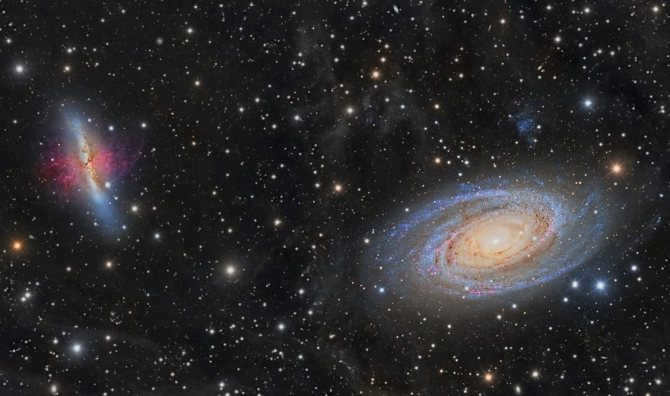
Galaxies M81 and M82 can be found at a distance of 12 million light-years from our planet. They are known as the Cigar and Bode galaxies, respectively. M101, on the other hand, is called the Vertushka galaxy. The Cigar galaxy is particularly famous for its stunning appearance in space, with its arms emitting a beautiful violet-blue glow and a distinct blue sphere at its center.
The Vertushka galaxy, with its spiral shape, is characterized by its long rounded tails and the presence of numerous bright objects surrounding it. Astronomers often compare these bright objects to fireworks, as they resemble exploding fireworks in the night sky.
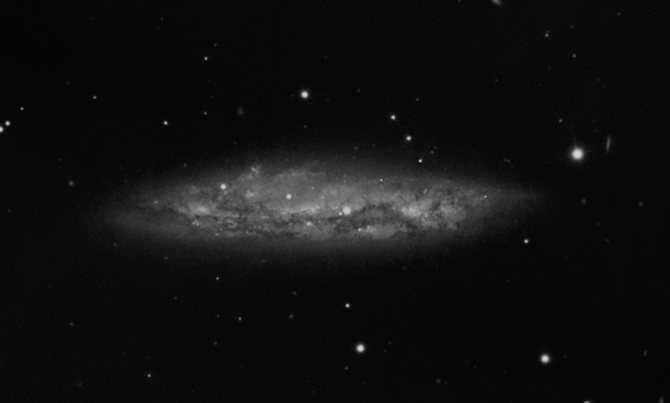
Galaxy M108
M108 galaxy can be observed near the star Merak, but its central region is concealed by dust clouds. These clouds not only block the view of its center, but also absorb its brightness, making it appear around 12m when observed from Earth.
M109, known as the Dustman galaxy, can be seen not far from the Feqda luminary. It is considered to be one of the most challenging objects to observe due to the frequent overlap of its glow with nearby stars.
Astronomers regularly discover new galaxies with unique characteristics in the sector where the White Bear is located. Its favorable position in the sky allows for the observation of even the most distant objects.
The Big Dipper: spotting the dipper during autumn
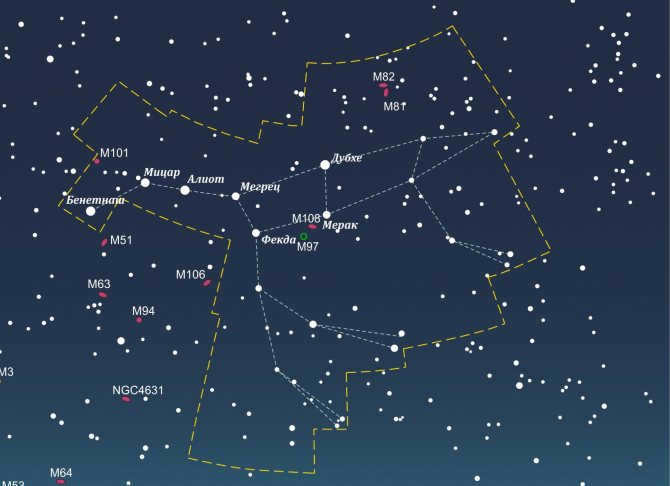
A detailed picture of the Great Bear
Due to the continuous movement of all celestial objects, the Great Bear can be found in different parts of the night sky at different times of the year. During the autumn season, many stars are obscured from view. However, the asterism of the constellation is an exception to this rule. Its seven main stars, although not as bright from September to November, can still be easily observed with the naked eye.
In autumn, the Great Bear can be found in the northern part of the sky, situated below Polaris. The constellation’s well-known shape resembles a dipper, with its handle pointing towards the west. To the east, one can also spot the Pleiades constellation, with the bright star Aldebaran nearby. Moving towards the northeast, the prominent stars that form the Gemini constellation are visible.
However, not all constellations are visible in the autumn. Virgo and Leo extend beyond the horizon in Russia, and the Eagle constellation is barely visible from behind the Big Dipper in the western region.
In the autumn night sky, the most prominent constellations are:
- Ursa Major (the Big Dipper)
- Orion (the Hunter)
- Taurus (the Bull)
- Cygnus (the Swan)
- Pegasus (the Winged Horse)
- Cassiopeia (the Queen)
These constellations can be observed at night without the need for special equipment. However, astronomers rely on professional telescopes to observe other celestial objects. These telescopes have enough power to bring stars and galaxies of interest closer. For instance, the Hubble telescope can study over a thousand galaxies located within the stellar region of the Big Dipper. This allows scientists to continue their work without seasonal interruptions.
Various Titles
Originally, this particular section of the sky was associated solely with the Big Dipper asterism, resulting in the use of appropriate names:
- The constellation was known as Helica by the ancient Greeks, which can be translated as “shell,” and sometimes as Arctos, meaning “bear” or “bear.” According to certain Greek authors, the Big Dipper served as a navigation tool for the ancient Greeks. According to Greek mythology, Zeus transformed two Cretan nymphs into bears to protect them from Cronus. Another version of the story suggests that the nymph Callisto was transformed into a bear to hide from her sister and wife, Hera.
- The Sanskrit name for the constellation is “Sapta Rishi,” meaning “seven sages.” This name refers to the seven sons of the god Brahma, who are believed to be the ancestors of all and the actual creators of the universe. In Indian astronomy, the seven stars of the Big Dipper are referred to by the names of these sages.
- The Kazakh nomads refer to the constellation as “Seven Robbers” (Zhetikarakshy). According to legend, the supreme sky deity Tengri tied his two horses to the Iron Peg. The Iron stake (“Temirkazyk”) represents the North Star, while the horses symbolize two stars in close proximity (likely Polar A and Polar B). The seven stars of the Big Dipper are seen as robbers attempting to steal the horses, causing them to continuously orbit around them.
- In ancient times, Chinese astronomers referred to the constellation as “Beidou” or “Northern Bucket” due to the fact that the handle of the Big Dipper pointed towards the North Pole.
- Within Slavic culture, this constellation was known as the “Elk” as it was originally linked to this majestic animal. In ancient Russia, the Big Dipper was also referred to as the “Horse on a Pin”, symbolizing the dipper as a horse pinned to Polaris, constantly circling around it – like a pin.
The Big Dipper: Debunking Common Myths about its Origin
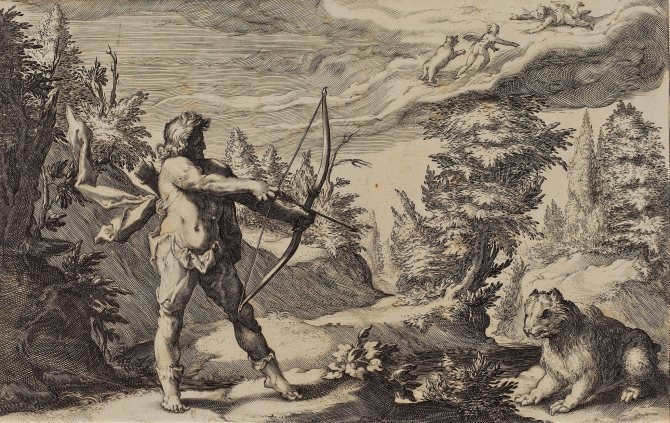
Arcade and Callisto
There are various myths surrounding the origin of the constellation. One of the most fascinating and well-known is the Greek legend. As previously mentioned, it revolves around Callisto, the daughter of the king of Arcadia, who caught the attention of Zeus.
However, there is another version of the myth. In her youth, Artemis frequently ventured into the forest for hunting, hoping to encounter different kinds of game. Accompanying her were young girls of extraordinary beauty. Among them, Callisto stood out the most.
There exists a multitude of unique constellations. Some of them are widely recognized by all, while others remain known only to a select few. However, within this vast expanse of nocturnal celestial bodies, there exists a group that is universally understood. In this article, we will explore the positioning of the Big Dipper and the Little Dipper. Constellations are often accompanied by a plethora of legends, and we will delve into a few of them as well. Additionally, we will highlight the most prominent and radiant stars that can be observed within this popular cluster.
The night sky is always captivating and never fails to draw attention.
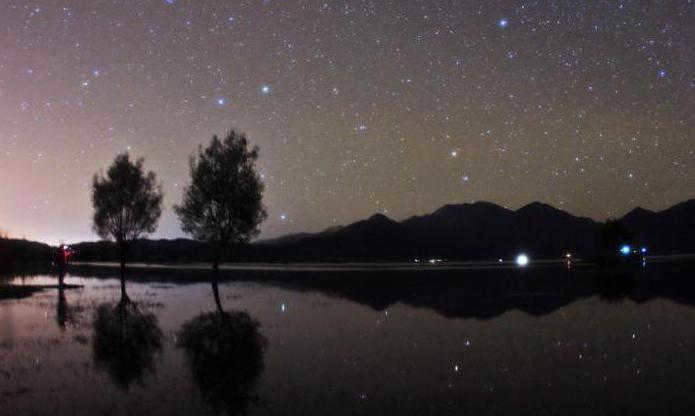
The celestial expanse, the Great Bear, the Little Bear, Andromeda, the Southern Cross… What could be more stunning and majestic? Countless stars twinkle and gleam, captivating curious minds. Throughout history, humans have sought their position in the cosmos, pondering the workings of the world, their place within it, and their divine origins. Gazing into the night sky beside a crackling fire, individuals have come to understand a simple truth – the stars are not haphazardly scattered across the heavens. They hold their rightful positions.
Each evening, the stars remained unchanged, in the same position. Nowadays, it is common knowledge that the stars are located at varying distances from the earth. However, when gazing up at the sky, it is impossible to determine which celestial bodies are further away and which are closer. Our predecessors were only able to differentiate them based on the intensity of their luminosity. They selected a small fraction of the brightest stars, organized them into distinctive patterns, and labeled them as constellations. In contemporary astrology, there are 88 recognized constellations in the starry sky, whereas our ancestors were aware of no more than 50.
The constellations were given various names, connecting them to objects such as Libra, Southern Cross, and Triangle. The luminaries were named after heroes from Greek mythology, such as Andromeda, Perseus, and Cassiopeia. Stars were given names that either represented real or imaginary animals, such as Lion, Dragon, and the Big and Little Dippers. In ancient times, people displayed their imagination fully when it came to naming celestial bodies. It is not surprising that these names have remained unchanged to this day.
The constellation known as the Bucket Cluster
Among the various clusters of stars that adorn the night sky in the northern hemisphere, the Big Dipper and the Little Dipper hold a special place as the most famous and easily recognizable. The stars that make up the Big Dipper form a distinct shape resembling a dipper, and their names are well-established. This cluster of celestial bodies is considered the third largest in terms of magnitude, with only the constellations Virgo and Hydra surpassing it. In total, there are 125 stars in the Big Dipper, all of which can be observed with the naked eye. The bucket shape is created by seven of the brightest stars, each of which has its own unique name.
Now let’s focus on the famous constellation known as the Big Dipper. It is truly an essential part of the celestial world. Within this star cluster, we can identify:
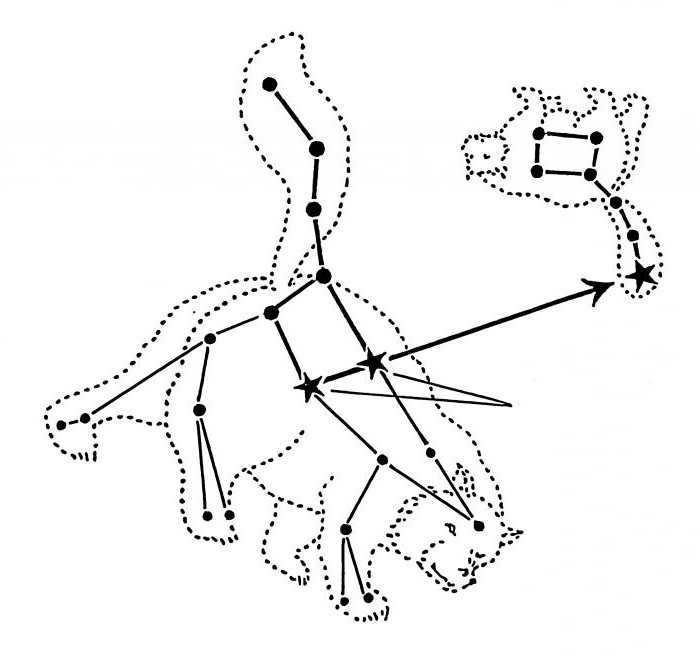
Dubhe, the brightest star in the Big Dipper, gets its name from the word “bear”. Merak, the second brightest star, means “loins”. Fekda translates to “thigh”. Megretz signifies the “beginning of the tail”. Aliot is known as “curd”. Mitzar is referred to as “loincloth”. Lastly, Benetnash is literally called the “leader of the mourners”.
These are just a few examples of the many stars that comprise this well-known constellation.
The motion of a constellation across the celestial sphere.
Locating the constellation of Ursa Major and Ursa Minor in the night sky is relatively simple. It is most visible during the months of March and April. On crisp spring evenings, we can easily spot the Great Bear directly above us. The stars are positioned high in the sky. However, after mid-April, the star cluster gradually shifts westward. Throughout the summer months, the constellation moves slowly towards the northwest. By the end of August, the Big Dipper can be observed very low in the northern direction. It remains there until the arrival of winter. During the winter season, Ursa Major will once again rise above the horizon, initiating its movement from north to northeast once more.
Shifting the position of the stars based on the time of day
Pay attention to how the arrangement of the Big and Little Dipper constellations shifts throughout the day. For instance, during the night in February, we observe the bucket with its handle pointing downwards, situated in the northeast. However, in the morning, the constellation will shift to the northwest, and the handle will turn upwards.
Fascinatingly, the five stars within the bucket form a distinct group and move separately from the other two stars. Dubhe and Benetnash gradually move away in the opposite direction from the other five stars. Consequently, in the near future, the dipper will assume an entirely different appearance. Unfortunately, we won’t be able to witness it, as the noticeable change will take approximately a hundred thousand years to occur.
The mystery of the celestial bodies Mizar and Alcor
Within the cluster of magnificent stars that form the Big Dipper, there exists a captivating celestial pair – Mizar and Alcor. What makes them so intriguing? Throughout ancient times, these two stars were utilized as a means to gauge the sharpness of human vision. Mizar, situated within the handle of the Big Dipper, is a star of medium size. Adjacent to it lies the scarcely discernible Alcor. A person blessed with excellent eyesight will effortlessly perceive these two stars, while an individual with poor eyesight will perceive them as a solitary luminous point in the sky. However, these two stars conceal a couple of additional astonishing enigmas within their celestial embrace.
The human eye is unable to perceive the inherent characteristics within them. When a telescope is directed towards Mizar, instead of one star, two stars can be observed. These stars are referred to as Mizar A and Mizar B. However, there is more to it. Through spectral analysis, it has been discovered that Mizar A is composed of two stars, while Mizar B is composed of three stars. Regrettably, these celestial bodies are located at such a great distance from Earth that no optical instruments possess the capability to fully unveil their secrets.
Stars from the Ursa Minor constellation
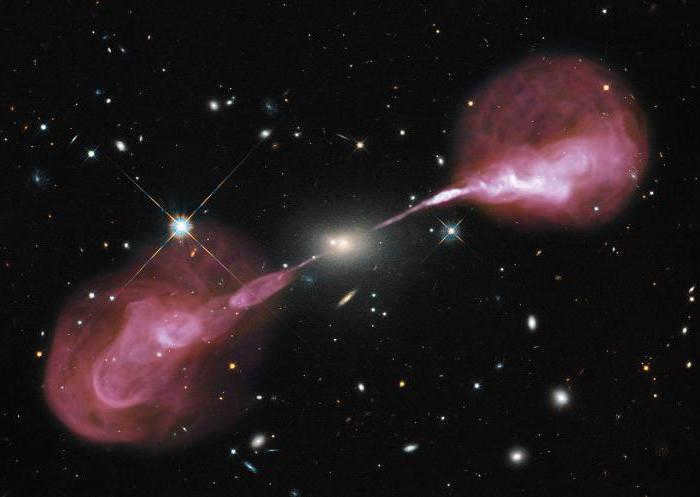
The two stars situated on the edge of the dipper are known as the Pointers. These stars, named Merak and Dubhe, earned their title due to the fact that if you draw a straight line through them, it will lead you to the polar star in the constellation of the Little Bear. This grouping of celestial luminaries is also referred to as semi-polar. The roster of stars within the Little Bear constellation encompasses a total of 25 names, all of which are visible to the naked eye. It is worth noting that some of these stars are particularly well-known and are also the most brilliant.
The star Cohab played the role of a guiding light for sailors during the period from 3000 B.C. to 600 A.D. This celestial body, which includes the constellation of the Little Bear, served as a reference point, indicating the direction towards the North Pole. Among the other notable stars in this cluster are Fercadus and Yildun.
For a considerable period of time, there was no widely recognized name for this star
The constellation known as Ursa Minor resembles a ladle, similar to Ursa Major. The Phoenicians, who were renowned navigators in ancient times, utilized this cluster of stars for navigation purposes. However, Greek sailors primarily relied on Ursa Major. The Arabs perceived Ursa Minor as a rider, a monkey with red skin, which held onto the center of the world with its tail and revolved around it. As we can see, there was no universally accepted interpretation or name for a significant period, and each nation found its own unique and easily understandable representation in the starry sky. What else can the constellation Ursa Major reveal about itself?
Legends surrounding the constellation. Dubhe, the shining star
There are countless legends and stories surrounding the collection of bright stars that make up the Big Dipper and the Little Dipper.
One such legend revolves around Dubhe, the brightest star in the Big Dipper constellation. According to this belief, Callisto, the beautiful daughter of King Lycaon, was a hunter in the service of the goddess Artemis. The mighty Zeus became infatuated with Callisto and she bore him a son named Arkas. In a fit of jealousy, Zeus’ wife Hera transformed Callisto into a bear. As Arkas grew older and became a hunter himself, he stumbled upon the bear and prepared to shoot it with an arrow. However, Zeus intervened and prevented the killing. Instead, he transformed Arkas into a smaller bear. To ensure that the mother and son would always be together, Zeus placed them in the night sky as constellations.
The story of a tiny group of celestial bodies
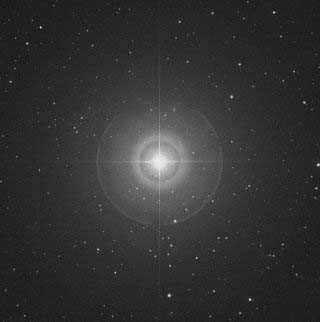
Legend has it that the constellation of Ursa Minor, also known as the Little Bear, has an interesting backstory. According to the tale, Rhea, the wife of the Greek god Cronus, saved her son Zeus from being devoured by his father. She hid the baby in a cave, where he was cared for by two nymphs named Melissa and Helis, in addition to a goat. As a reward for their help, Zeus later transformed Melissa and Helis into bears and placed them among the stars in the night sky.
The Myth of the Constellation’s Origin According to Greenland’s Storytellers
In the remote region of Greenland, there exists a legendary tale centered around the constellation known as the Big Dipper. The mythology and historical significance surrounding this cluster is widely known. However, amongst the Eskimo community, there is one particular story that has gained immense popularity and is shared by all. It has even been suggested that this tale is not mere fiction, but rather a depiction of pure truth.
In a snow-covered dwelling, situated on the very outskirts of Greenland, resided the majestic hunter named Eriulok. He lived a solitary life in his humble abode, driven by his arrogance and the belief that he was unmatched in his craft. Consequently, he had no desire to interact with his fellow tribesmen. For countless years, Eriulok ventured out into the sea, consistently returning with bountiful spoils. His dwelling was always filled with an abundance of food and seal oil, while the walls were adorned with the finest skins of walruses, seals, and other marine creatures. Eriulok was undoubtedly wealthy and well-fed, yet plagued by a sense of isolation.
As time went on, the weight of this loneliness began to take its toll on the majestic hunter. He attempted to forge friendships with his fellow Eskimo tribesmen, but they were unwilling to associate with the arrogant kin. It seemed that Eriulok had committed grave wrongs against them in the past.
Feeling hopeless, Eriulok journeyed to the Arctic Ocean and invoked the goddess Arnarkuachssak, the ruler of the deep sea. He shared his story of failure with her. The goddess offered to assist, but on the condition that Eriulok retrieve a ladle filled with magical berries that could restore her youth. The hunter agreed and embarked on a voyage to a distant island, where he discovered a cave guarded by a bear. After a long struggle, he managed to lull the forest creature to sleep and pilfer the ladle containing the berries. True to her word, the goddess rewarded the hunter with a spouse and, in exchange, received the marvelous berries. Following his eventful adventures, Eriulok married and became the proud father of a large family, much to the envy of his neighbors. As for the goddess, she devoured all the berries, regaining several centuries of youth, and joyfully tossed the empty ladle into the sky, where it became entangled and remained suspended.
A heartwarming tale of light and darkness
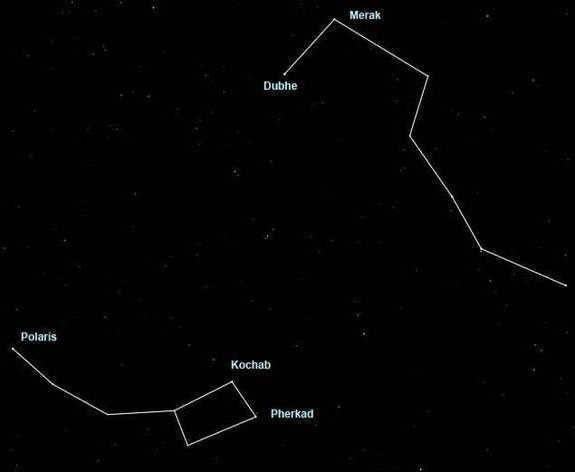
The aura of enigma has vanished due to advancements
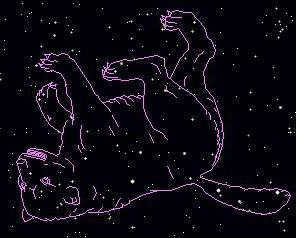

Throughout history and in modern times, constellations have served as guides for us in navigating the vastness of space. Travelers and sailors have relied on the brightness and positioning of constellations to determine time, find their way, and more. In today’s world, we don’t gather around fires as often, nor do we frequently gaze up at the enigmatic, starry sky and weave tales about the Big and Little Dippers, Cassiopeia, or Canes Venatici. Few individuals can point out the Big and Little Dipper constellations. Our knowledge from astronomy lessons tells us that stars are incredibly distant, and many of them are actually akin to our own Sun.
The advancements in optical telescopes have resulted in numerous discoveries that our ancestors were completely unaware of. It’s remarkable that humans have even been able to journey to the Moon, collect samples of lunar soil, and successfully return. Science has lifted the veil of mystery that shrouded the celestial bodies for centuries. Yet, we still gaze up at the sky, searching for constellations such as the snow-white Bear, the majestic Leo, or the crawling Cancer. Many people enjoy gazing at the cloudless night sky, where they can witness a multitude of stars, their formations, and clusters.
Summary
This article examines the Big Dipper and Little Dipper constellations. Locating these constellations in the night sky is a relatively easy task that many people have attempted, and some continue to do so today.
